BACK ON THE HORSE
How champion gymnast MAX WHITLOCK turned fear into fortitude

BEYOND THE ORDINARY SUBSCRIBE: getredbulletin.com UK EDITION OCTOBER 2023, £3.50
Expand your comfort zone with the all-new generation of Endurace. Signature speed, benchmark compliance, an adaptive t and integration that enhances each ride, the new Endurace is made to make distances disappear. Go long.










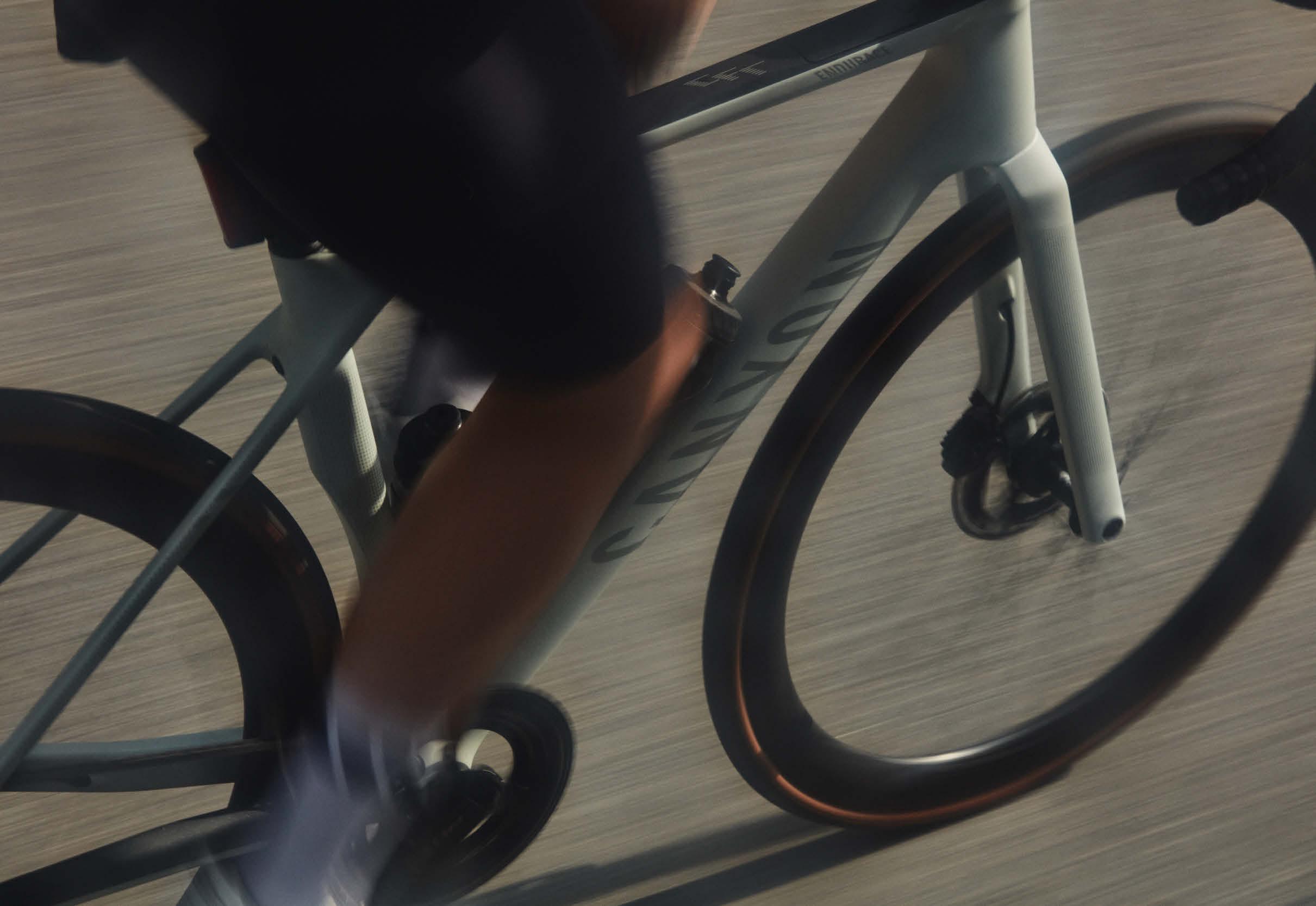










BOUNCING BACK
When the going gets tough, Billy Ocean told us, the tough get going. This nugget of 1980s wisdom is borne out in this month’s issue, which features stars who have overcome serious lows to reach new heights. Olympian Max Whitlock left gymnastics when a fear of failure eroded his gold medal-winning confdence. But he’s found a path back to the gym – and further Olympic glory in 2024. Winning wasn’t the aim when downhill ace Tahnée Seagrave united six of MTB’s leading lights in Wales; it was a chance for women riders to work towards competing in hardcore contest Red Bull Hardline. But after returning from a serious concussion, the experience became more signifcant for Seagrave than she imagined. And we delve into Bradford’s vibrant bassline scene, a homegrown sound that’s creating new possibilities in an area of the UK where opportunity is scarce. Enjoy the issue.

Contributors
ALICE AUSTIN


The Tel-Aviv-based journalist has written extensively about the intersection of politics and music, so was drawn to Bradford’s bassline scene. “It feels like parts of the city have been forgotten. That’s why this wildly energising scene is such a triumph. It gives the youth of Bradford hopes, dreams… and endless banter.” Page 52
SAMANTHA SASKIA DUGON
Born in Swansea, and a keen mountain biker herself, the photographer jumped at the chance to shoot the inaugural Red Bull Hardline Women’s Progression Camp. “I’ll never forget seeing Tahnée [Seagrave] hit the Cannonball step-down for the first time. The sense of joy when she landed it was off the charts.” Page 40
HAMISH BROWN
The photographer has shot everyone from Jay-Z to Harry Kane, but working with Max Whitlock for our cover left a lasting impression. “His Olympic medals are slightly marked around the edges because he’s ditched the ‘look, don’t touch’ approach so kids can feel them and be inspired by his achievements.” Page 30

EDITOR’S LETTER
04 THE RED BULLETIN HAMISH BROWN (COVER)
What’s this, a pile of Max Whitlock’s old socks? Not quite – this is how the gymnast transported his six Olympic medals to our shoot. Page 30




14
16
WOMEN’S SKYDIVING 18
MUSHROOM SURFBOARDS 21 SISTER MIDNIGHT 22
HEROES
CAINE HARRISON 24
He may dance like an alien, but the UK B-boy’s tale of despair and renewed determination is all too human
CESALINA GRACIE 26
For this Brazilian, jiu-jitsu is a state of mind. Now she’s using it to empower women to reclaim their lives
EUGENE AMO-DADZIE 28
Question: an athlete ran 100m in 9.93 seconds – at what speed did he travel? This accountant-turnedsprint ace can do the maths
GYMNASTICS
Overwhelmed by the pressure to win, the Olympic champion gymnast had to walk away from his sport. But now a willingness to confront and discuss his fear has opened the door to his return
BIKE
RED BULL HARDLINE 40
Six elite women riders assemble in Mid Wales to tackle the most notoriously tough course in downhill MTB – and show that a podium place in the competition is long overdue

CULTURE
52
Straight outta West Yorkshire: inside the grassroots music scene born from a disenfranchised community, where every day brings a new banger and the bucket hat is king
Water: not only the essence of life but, for this surf photographer, a limitless source of inspiration. The Hawaiian shares a selection of his most cherished images
CONTENTS 40
GALLERY 8
PLAYLIST: RÓISÍN MURPHY
BOTH SIDES RETREATS
MAX WHITLOCK 30
BASSLINE
SURF ZAK NOYLE 62
VENTURE TRAVEL 75 FITNESS 80 EQUIPMENT: BOTTLES 82 HOW TO 84 GAMING 86 FITNESS GEAR 87 EQUIPMENT: BACKPACKS 88 BAR GUIDE 93 CALENDAR 94 SEMI-RAD 98 THE RED BULLETIN 07 SAMANTHA
SASKIA DUGON
COMPANY FLOW
If there’s one thing that’ll make a waterfall dive more perilous, it’s a synchronised team element. Even a Red Bull Cliff Diving World Series champ isn’t that reckless, so, for this shot from their ‘Dive into Guatemala’ project this April, Rhiannan Iffland (pictured x13), Jonathan Paredes and Orlando Duque had to rely on photo wizardry. Well, their task did include a 1,500km road trip and this drop from the 35m-high Los Amates fall, so let’s cut them some slack, eh? For the full story, watch Cliff Hunter at redbull.com
 Santa Rosa, Guatemala
Santa Rosa, Guatemala
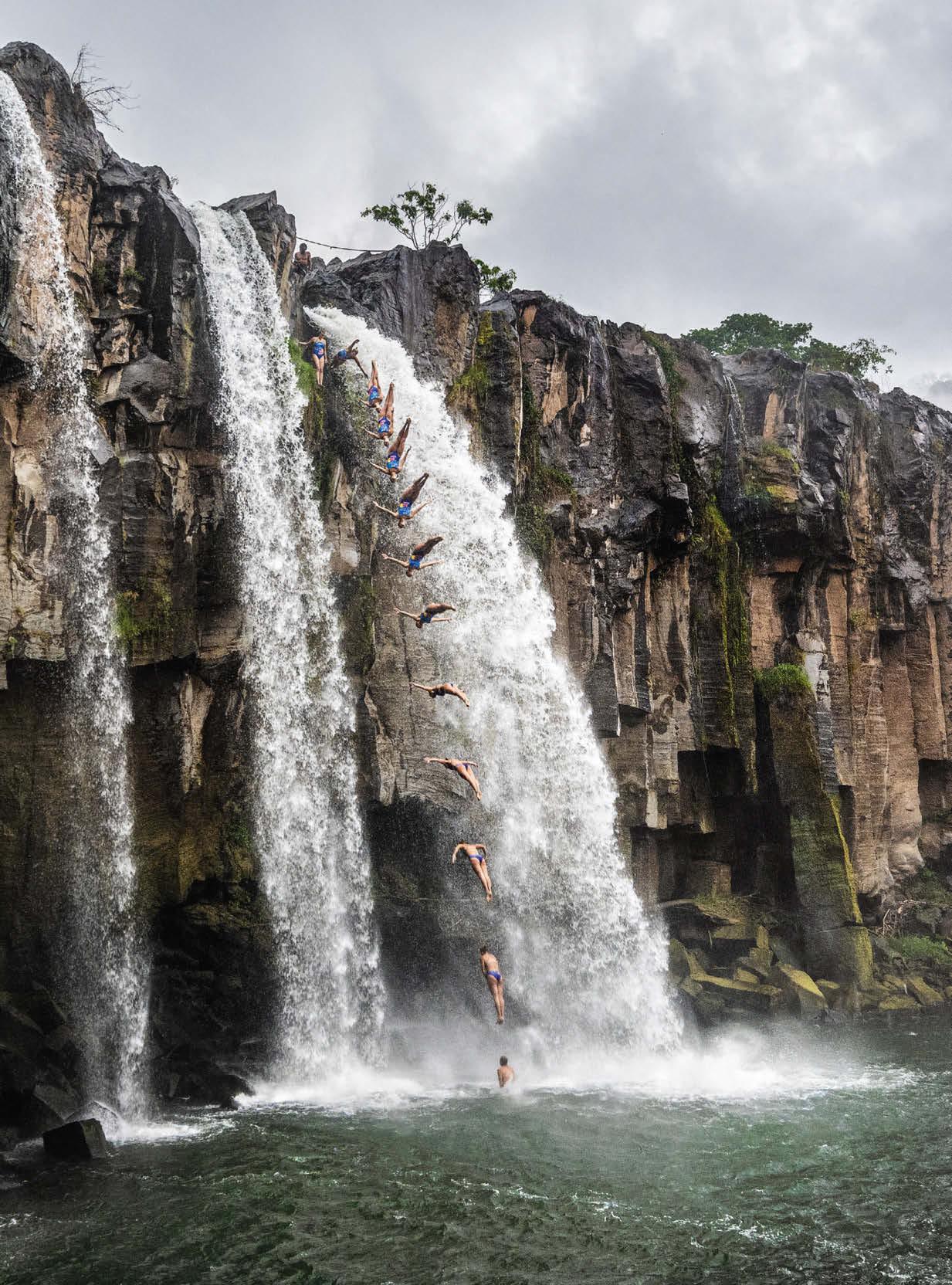
09 DEAN TREML/RED BULL CONTENT POOL DAVYDD CHONG
Hutovo Blato, Bosnia and Herzegovina
REED ON
Covering almost 80sq-km, Hutovo Blato Nature Park is home to a biologically diverse array of fauna and flora. Much of its wetlands are overgrown with reeds – the ideal environment for wildlife including herons, cranes, and the brightly coloured kayaker. Serbian photographer Predrag Vuckovic used a drone to achieve a bird’s-eye view of extreme canoeists Peter Kauzer and Darko Savic during their epic 100km kayaking adventure through Bosnia and Herzegovina in April this year. In this shot, which won Photo of the Month on Red Bull Content Pool, we see Kauzer being besieged and eaten by sentient reeds as he tries to escape the resident lake serpent… no, wait, we’re getting our nature reserves mixed up again. Kauzer’s fine, just fine. redbullcontentpool.com

Naxos, Greece
HIGH RISE
If your first response to this image is, “Ooh, doesn’t the sun look lovely,” you’re probably not much of a watersports aficionado. Still only 19 years old, German-born Greek freestyle windsurfer Lennart Neubauer –shot here by Athens-based photographer Alex Grymanis – is a phenomenon in his sport, with championship titles across numerous age categories. For the Lennart Neubauer’s Wind Park project in 2021, he returned to the place where he learnt his craft – Laguna Beach Park on the Greek island of Naxos – to ride custom-built kicker ramps and sliders on a specially reinforced board. And nothing could spoil the then 17-year-old’s fun – not ferocious winds, a torn sail on day two, or even the fact that he had to attend school every morning before filming. There’s dedication for you…
 Watch
Lennart Neubauer’s Wind Park at redbull.com
Watch
Lennart Neubauer’s Wind Park at redbull.com
11 PREDRAG VUCKOVIC/RED BULL CONTENT POOL, ALEX GRYMANIS/RED BULL CONTENT POOL DAVYDD CHONG
Dubai, UAE
SAND WAVE
Billed as “the ultimate motocross playground”, MXRide Dubai is a training centre for riders that borders the 225sq-km Dubai Desert Conservation Reserve, the United Arab Emirates’ first national park. This means visiting bike fiends are guaranteed sand to ride on – lots of it. Latvian photographer Volodya Voronin took this dramatic shot of 31-year-old Jordanian enduro and motocross champ Abdullah Abu Aisheh, aka Al Sab3, kicking up a (sand) storm at the facility in June this year. redbullcontentpool.com


13 VOLODYA VORONIN/RED BULL CONTENT POOL DAVYDD CHONG
Murphy’s lore
The former Moloko singer revisits four songs that helped get her where she is today

In 1994, Irish singer Róisín Murphy approached music producer Mark Brydon at a party in Sheffield with the line, “Do you like my tight sweater?” A year later, it was the title of their debut album as trip-hop duo Moloko. Together, they created dancefloor classics and sold more than half a million albums. When Moloko ended in 2005, Murphy went solo; this month she releases her sixth album, Hit Parade, produced by DJ Koze. “The studio in this case was imaginary, in the airspace between Hamburg and London,” says Murphy, 49. “For me, that brought out a more intimate approach to the songwriting. I told this album my secrets.” Here, she shares four songs that have shaped her life and career so far. Hit Parade is out now; roisinmurphyofficial.com
Hoagy Carmichael Star Dust (1929)

“My father sang this a lot when I was growing up. He was a great singer and knew hundreds of songs. He’d play a game with me where he’d go, ‘Say anything, I bet I know a song about it.’ This particular one, made famous by Nat King Cole, is very magical. It sounds fantastical, especially from a child’s point of view, looking up at an adult singing it. It was like a fairy tale to me.”
Grace
Jones
Pull Up to the Bumper (1981)
“I saw Grace Jones before I heard her music. A friend’s family had the vinyl sleeve of her album Island Life on top of their fireplace. I was like, ‘Is this a human? Is it a computer graphic?’ Later I saw the [Citroën car advert] where she drives out of her own mouth, and it was the coolest thing. She’s still the coolest artist in the world and a hero of mine.”

The Stooges

I Wanna Be Your Dog (1969)
“When I was a kid, I saw Sonic Youth [cover this at] a gig in Brighton with their support act Mudhoney, and the place went mad. It’s so avant-garde. Years later, I learnt that if you only listen to the left-hand [speaker] it sounds like jazz, and on the right it’s like rock – [the sounds] are separated. Iggy Pop is a big influence as a [live] performer. He’s like a bullet out of a gun.”
DJ Koze XTC (2015)
“I first heard this track after he sent me a very ballsy email. It said something like, ‘I am the Muhammad Ali of producers –you need me!’ I was intrigued and found XTC. I was in heaven! It has a delicate-as-lace quality and yet this deep, stirring part, too. Then there’s the humour of this woman talking about trying ecstasy. I was like, ‘Hell yeah I’m going to work with you!’”

RÓISÍN MURPHY
14 THE RED BULLETIN NIK PATE FLORIAN OBKIRCHER
Scan the QR code to hear our Playlist podcast with Róisín Murphy on Spotify
KEEP THE COLD COLD. THE HOT HOT. AND THE WILD WILD.
The RAMBLER® 18 OZ (532 ML) BOTTLE WITH CHUG CAP and double-wall vacuum insulation follows you wherever the wild takes you. And back home again.

 Ambassador Leo Houlding
Ambassador Leo Houlding
BOTH SIDES RETREATS
Man kind
A different type of lads’ weekend, these ‘rewilding’ getaways use the outdoors to reconnect men with their feelings – and each other
A group of shirtless men with impressive tans sit crosslegged in an open meadow, meditating. Already today they have leapt into a lake, practised jiu-jitsu, and embraced one another in shirtless hugs. Later, after yoga and group breath-work, they’ll gather around a campfire and share their innermost thoughts.
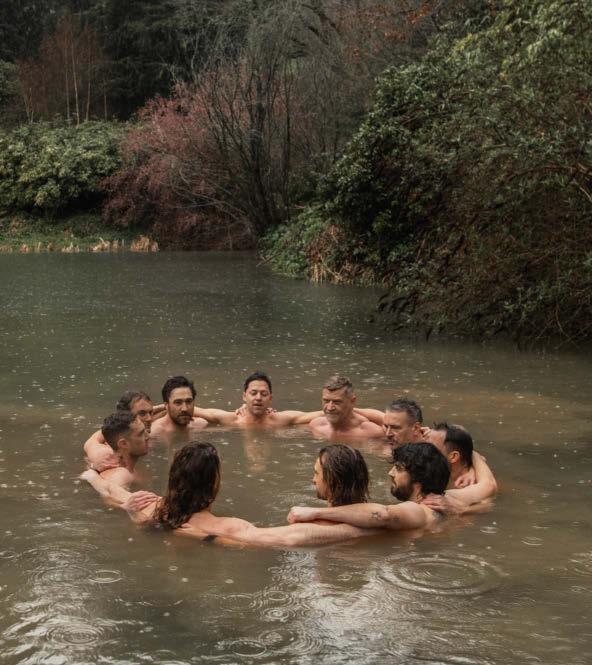
But these men aren’t close friends – in fact, they’re strangers. This is Both Sides, a ‘rewilding retreat’ founded in 2020 by mates Anthony Mullally and Josh Bolding. Its purpose is to immerse men in nature while “exploring personal growth practices, fostering new brotherhoods, and reconnecting [them] with their most authentic selves”.
An exclusive all-male, threenight retreat in the wilds of the
UK might elicit an eye roll, but that’s part of the problem, says Mullally, 32. Both Sides is a haven where men can to be emotionally vulnerable together and dismantle what its co-founder sees as the toxic patriarchal programming almost all men have internalised throughout their lives.
“I retired from professional rugby [league] about 10 months ago,” says Mullally who, during a playing career with the likes of Widnes Vikings, Leeds Rhinos and the Ireland national team, was nicknamed ‘the Vegan Warrior’. “But during my time in professional sport I was never certain how I was expected to conduct myself as a young athlete or as a young man. There was no roadmap, and I developed some unhealthy behaviours.”
In meditation, conscious connected breathing – a technique where there’s no pause between inhalation and exhalation – and yoga, Mullally discovered an access point to untangle and reassess his own notions of masculinity.

“Many of us are striving to prove something, or to conform to false ideals of what a man ‘should be’,” he says. “Generations before us didn’t accept men’s [vulnerable] feelings and would associate them as weaknesses. If there was an issue with you, that meant you were weak. Men were told to push it down and suppress the emotional side of ourselves, and it wasn’t healthy.”
Given the alarming influence of negative male role models on social media, alongside escalating rates of male suicide, initiatives that foster men’s ability to seek help shouldn’t be dismissed.
“The only guidance I ever received from other men was through sports initiations, which revolve around aggression, dominance, oneupping each other and seeking external validation,” says Mullally. “I wanted to create a different environment where men can come together with gentleness and question the false male archetypes we’re taught, such as being stoic and competitive. By cultivating comfort in being vulnerable together, we can establish new and healthier ways to embody masculinity in the world.” bothsidesretreats.com
16 THE RED BULLETIN
Brothers in arms: (from top) reconnecting at a Both Sides retreat; co-founder Anthony Mullally
JOHN PORTLOCK
LOU BOYD
ISRAEL, EXACTLY LIKE NOWHERE ELSE

Where adrenaline and history are joined together, and 4000-year-old cities set the scene for the future of technology. Here, the combination of ancient and modern is harmoniously blended.
fnd us at goisrael.com
WOMEN’S SKYDIVING Falling into place
In skydiving, women are still massively underrepresented. This world record-breaker wants to change that
“Skydiving opens a door in your psyche,” says American Melanie Curtis, who, thanks to her pilot father, completed her first descent from an aeroplane at just three months old. “It gives you a whole new perspective that you can do things you never thought you could, and that’s so powerful.”
However, according to a survey conducted in 2021 by the United States Parachute Association, only 14 per cent of its skydivers identify as female, a disparity reflected in the wider world. Now Curtis, founder of the non-profit Women’s Skydiving Network, is aiming to change these statistics by inspiring more women to reap the benefits of leaping from a great height armed only with a parachute.

“We don’t know why more women don’t skydive,” says

Curtis. “I think part of it is the underrepresentation. If a woman steps into a drop zone and only sees a bunch of men, it’s understandable that she might feel less comfortable, or that this place isn’t for her. We want to make it very clear that women are welcome here.”
What better way to raise awareness of this than by uniting women already taking giant leaps? In November last year, Curtis gathered 80 women from 22 different countries at an airfield in Arizona. They boarded five Cessna planes, took to the sky, then jumped from around 6,000m. Flying upside down at 260kph, they linked in mid-air to set a new world record for the largest-ever all-female skydive.
Curtis is using the team’s success as a starting point for important wider conversations
on the subject of women’s underrepresentation in various spaces. “[Skydiving] is this shiny, sexy thing,” she says.
“It has the power to capture attention. But how can we attach it to the conversations we want to elevate? What are [women] actively doing to do better? How are we taking up spaces in rooms where we’ve been underrepresented in the past? How are we using our voice in the world?”
Having achieved her goal of setting the world record, Curtis now has her sights set on beating it with a potential 100-woman skydive next year. “We want more women to join us in skydiving,” she says.
“But even more than that, we want women and girls to look at us and think, ‘I can live a bold, brave life, too.’”
womensskydivingnetwork.org
18 THE RED BULLETIN EWAN COWIE, IRINA LEONI TOM WARD
Chain reaction: (from top) that spectacular, recordbreaking skydive – named Project 19 – in Arizona last November; Melanie Curtis, founder of the Women’s Skydiving Network
When the day ends, the fun begins.



Diablo Mk14 Helmet Mounted Tap Technology 2000 Lumens Sixpack Mk13 Bar Mounted Refex Technology 5450 Lumens
Heads. Quite important things really, you could go so far as saying essential even. At Endura, we certainly value them, which is why we not only apply all our own engineering prowess to them, but we also bring in key expert partners to help make our helmets some of the very best out there.


For 99.9% of the time, they just need to look great, be comfortable and provide great ventilation… and we think we have that well and truly covered, literally, as the new MT500 helmet offers more coverage, plenty of vents and unrivalled comfort. For the other 0.01% of the time, and it’s an astronomically important 0.01% of the time, the helmet needs to provide the best possible protection it can and here we offer up the triple whammy combination of Endura x Mips x Koroyd to really put our money where our mouth is in terms of rider safety.



endurasport.com




 STEVE DAVIES
STEVE DAVIES
Surfng shrooms
This 23-year-old surfer wants to make his sport eco-friendlier by growing and shaping boards from fungi
Surfers are known for their deep connection to the environment – they’re often aware of even subtle shifts in the ocean and the weather – and for their advocacy of marine conservation. What many don’t realise, though, is the serious damage that their favourite board could be doing to the planet.
Steve Davies, a surfer and product designer from Porthcawl, south Wales, is on a mission to revolutionise the surfboard industry. His goal is to convince surfers to ditch their fibreglass boards and ride a more natural material: mushrooms.
Modern surfboards are constructed from fibreglass and polyurethane, meaning their manufacture relies heavily on the petrochemical industry and results in significant environmental harm. And when eventually sent to landfill, these nonbiodegradable boards could – it has been estimated –take more than 500 years to decompose.
“Porthcawl is a little coastal hub, so surfing has always been a massive part of my life,” says Davies, 23. “I started to see a disparity between the surfboards in the water and the ethos of those who ride them. I started to consider whether I could create an alternative board, one that doesn’t take away from the planet and
the ocean. That’s when I discovered mushrooms could provide the answer.”
While working on his master’s degree in product design at Cardiff Metropolitan University, Davies came across designers who were using the mycelium network –an expanding system of fungal strands, similar to a plant’s roots – to create products and packaging. Inspired, he decided to harness the network to grow his own surfboards.

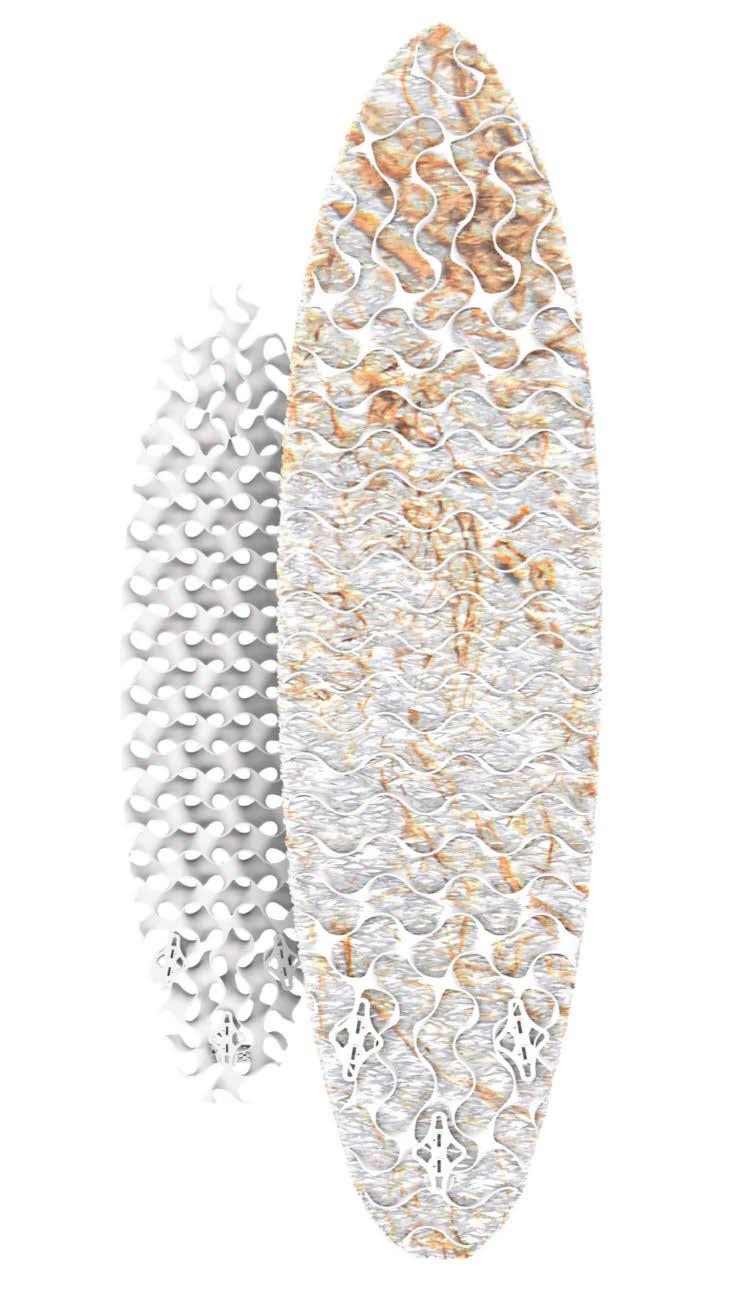
“Mushrooms grow from spores, not seeds,” says Davies. “You can slice up a mushroom from your breakfast plate and obtain thousands of spores that can be nurtured to grow a batch of mycelium, which acts as a root network. To create a surfboard-like shape, I impregnated agricultural waste such as hay with pre-grown mycelium within a boardshaped mould, allowing it to solidify into a rigid block. After a week, the block is removed from the mould, cooked and waterproofed. Then it’s ready for use.”
Davies is now working to make his surfboards as efficient and aesthetically pleasing as any modern fibreglass model, with the hope of being at the forefront of a new board industry that’s more in harmony with the planet.
Root and cause: a compostable filament skeleton (pictured, above left) provides the framework for a network of mycelium and hay (above right) to grow; (left) product designer Steve Davies with one of his boards
“I love the abundance and fast-growing nature of mycelium,” he says. “As it grows, it captures carbon. My boards are positively giving back to the environment. I can take one mushroom and just keep growing and growing it until I have a whole room of surfboards. That’s my dream: to have my own surfboard brand made from just one mushroom. I’m going to call it Shrooms.”
THE RED BULLETIN 21
STEVE DAVIES
LOU BOYD
SISTER MIDNIGHT
Cultural capital
With live music venues in London on the decline, this campaign group plans to buck the trend and give these vital spaces back to the community
It’s a familiar story: you stumble upon a hidden gem in your local area – a music venue with its own cultural community, built up over time. Then one day you discover it’s being shut down, destined to become another vacant shell on the high street, or – worse still – a luxury housing development.

Thanks to a combination of rapid gentrification and the escalating cost of living, many of those who run gig spaces in the UK – 97 per cent of which are privately rented – have found themselves locked in a battle with landlords, developers and local authorities to remain operational. And it’s a battle that most end up losing.
South London cooperative Sister Midnight is on a mission to combat this trend. Formed in 2021, the non-profit organisation – headed by Lottie Pendlebury, Lenny Watson and Sophie Farrell – plans to reclaim a cultural

space from private landlords and put it in the hands of music fans, creating Lewisham’s firstever community-owned live music venue.
Since the launch of its Crowdfunder two years ago, Sister Midnight has attracted financial support from music
acts including Fontaines DC, Porridge Radio, Goat Girl and Blackheath-born Jools Holland, as well as the capital’s ‘night czar’ Amy Lamé. The new, 250-capacity grassroots venue will be financed by local residents via the sale of community shares – minimum investment £100 – which also grant each member voting rights at the group’s AGM. “It’s one member, one vote,” Watson explains. “Voting power cannot be bought. When you’re working for the community, it’s pointless if those with all the money dictate everything.”
The campaign has secured the rent-free lease of a disused working men’s club, the Brookdale Club in Catford, for a minimum of seven years on the understanding that all funds raised – currently £267,900 – will go towards restoring the venue and creating a positive space for the community. There are plans for a community café as well as events including skills workshops and under-18s nights. “Live music will be the heart and soul of the place,” Watson says. “But there’s so much else a space like this can offer the community.”
Restoration of the venue has already begun, and Sister Midnight hopes it’ll be ready for opening at the start of next year. “Ideally, we walk away at the end of the lease with enough money for a down payment on a building we can purchase, so that the community can own a bit of their cultural infrastructure, the bricks and mortar,” says Watson. “That would be amazing for building local wealth.
“We want to open access to live music and culture for everyone, and to make a space where people can get involved in local creativity,” she continues. “To create somewhere solid and lasting.” sistermidnight.org
22 THE RED BULLETIN HOLLY WHITAKER, SISTER MIDNIGHT LOU BOYD
Night owls: (top, from left) Lottie Pendlebury, Lenny Watson and Sophie Farrell; the Brookdale Club, ready for renovation
TRIKE HYBRID
FEELS LIKE RIDING. BUT MORE.
CUBE TRIKE HYBRID
Developed in a unique collaboration between CUBE and BMW, the Trike Hybrid‘s sophisticated tilt mechanism is the key to keeping your cargo secure whilst maintaining the natural feel of a conventional bike. Bosch electric assist helps make light work of any route, whilst the short wheelbase and easy handling means this is a cargo bike that can be easily used by almost anyone.

CUBE-BIKES.CO.UK
CUBE BIKES UK
HEROES
OTHERWORLDLY TALENT
Dancing like an alien made Londoner CAINE HARRISON this year’s Red Bull Dance Your Style UK champion. Now he’s aiming to make history at the 2023 World Final in Frankfurt this November
WORDS LOU BOYD PHOTOGRAPHY YOSHITAKA KONO
Freestyle dance is hard to define. This competitive sport, in which dancers battle one-to-one, has few limitations. As long as routines are improvised on the spot and fit the style of music assigned on the day, competitors can draw from any genre – voguing to Afro dance to hip hop – and use the stage however they choose.
Discovering freestyle battles was a turning point in Caine Harrison’s dance journey. A hip-hop dancer from childhood, by 2021 the Londoner’s competition wins were getting him noticed and he began to think seriously about a future in dance. “Suddenly I started winning all the time,” says Harrison, now 20 and studying urban dance at the University of East London. “It was a shock to everyone, including me.”
Last year, he triumphed in the UK final of freestyle dance competition Red Bull Dance Your Style, winning himself a place in the World Final, where he’d gain the attention of a bigger, international audience. But things didn’t go the way Harrison had planned – due to an injury, he was knocked out in the first round.
Now, having won Dance Your Style UK for a second year running in May, he chats to The Red Bulletin about finding his passion and doing battle at the 2023 World Final with something to prove…
the red bulletin: When did you first start dancing?
caine harrison: My oldest sister was a dancer, and my godmother owned a dance school, so I started through them when I was about seven. I stopped when I joined secondary school, though. It wasn’t until I was 13 that I began discovering all the different parts of the dance scene and the places it could take me, and I started again. I joined a company in south London,
did some competitions and learnt to freestyle properly. That’s when I realised freestyle was what I wanted to do.
How would you describe your style?
It’s obviously hip hop – that’s fundamental – but on top of that I like to describe it as quite alien. People watching have said, “You look like you’re not from this planet.” That’s where my dance comes from. It’s hard to put into words. I like to go into weird positions and hit parts of the music in a way that no one has seen before. I don’t want to look human when I dance.
Did you win battles from the start?
Not at all. When I first entered them, I couldn’t even get through preselection. But when the pandemic happened, a lot of the best people in the scene moved on, which opened a space for new people to come up. I wanted to take advantage, so I trained every day and did my first battle in 2020. Suddenly, around mid-2021, the training paid off and I started winning.
You’re the youngest person ever to win Dance Your Style UK. How did it feel to triumph for the first time last year?
I was on a streak of winning battles around that time, and then I was selected as the wildcard for Dance Your Style. On the day, I just took my battles as they came, and suddenly I was in the Final. I was battling one of my friends, Matthew Eudu, which was nice because we come from the same sort of background. When I won, it was mad; I kind of broke down a bit. I was like, “I’m actually good enough.” It felt good.
What happened at the 2022 World Final in Johannesburg?
In the lead-up, I was battling a lot and travelling to dance outside the UK. But then, in October, I injured myself badly by rolling my ankle while practising flips.
I shouldn’t have danced for about three months, but I carried on. Then, when I arrived in South Africa for the final [in December], I twisted it again. Because of the pain, I started getting into my own head about the competition. I started thinking I wasn’t dancing out of love but [just to] impress people. It doesn’t work like that, because people feel your energy. The energy I was giving out suddenly felt fake because I was thinking about it too much. I didn’t even pass my first round.
How did you handle the setback?
I just thought, “Next year, I’m winning.” So I won the UK competition again this year, and now I’m heading back to the World Final. Obviously it’ll be difficult, but my mindset is to make an impact and do what I didn’t get to do last year.
How will your mindset be different?
The hunger is different. Last year, I didn’t really know what I wanted, but this time I’m focused because not many people get to go to the World Final twice. I feel like I’ve been given a second chance, so I want to bring it home. No one from the UK has ever won the World Final, so it would be a big step forward for the scene.
What piece of advice would you give to Dance Your Style newbies?
Just go out there and do it. Don’t try to fake energy for the crowd. Even a random person who doesn’t know anything about dance can still feel your energy. If you’re natural, you’ll make a deeper impact. You’ve just got to feel it in the moment. The Red Bull Dance Your Style World Final takes place in Frankfurt, Germany, on November 4; redbull.com
24 THE RED BULLETIN
 Caine Harrison is ready to go again at this year’s Red Bull Dance Your Style World Final
Caine Harrison is ready to go again at this year’s Red Bull Dance Your Style World Final
THE RED BULLETIN 25
“I’ve been given a second chance, so I want to bring it home”
HEROES
FIGHTING SPIRIT
Millions have been inspired by the Gracie men, the inventors of a 20th-century martial art – Brazilian Jiu-Jitsu (BJJ) –that swept the world. Gracie fighters not only founded the UFC, they’ve dominated in it. But what about the women?
Cesalina Gracie, the granddaughter of co-creator Carlos Gracie, has experienced a full arc with the sport, from living and breathing BJJ to dropping it completely. Then she met a young girl who helped her find true purpose in harnessing BJJ’s philosophy for everyday empowerment. Her target audience: women and girls, from as young as two and a half. It’s about more than self-defence. For young girls, it’s about learning how to deal with bullies (or not becoming one yourself). For women, it’s about seeing their own value, facing down harassment at work, or setting boundaries at home.
This, she realised, is the real value of jiu-jitsu: not forcing an opponent to submit, but using your voice to state your own needs; not winning in the ring, but adopting the ‘posture of the champion’ every day. Since 2018, the Brazilian has shared these ideas with thousands of women and girls through small classes in her current home base of LA and larger workshops around the world.
The Red Bulletin caught up with Gracie to discuss her work with BJJ and also her summitting of Everest, completed earlier this year despite zero mountaineering experience and a serious fear of heights…
the red bulletin: How was it growing up in a famous martial-arts family?
cesalina gracie: Jiu-jitsu is in my blood. We literally had mats in the living room, and I was the only girl on them. Those gifts I was learning and living and
breathing were spectacular, but when you’re so deep into it, you get to a point where you think, “Did I choose this, or did this life choose me? I need to figure it out on my own.” So at 17 I moved to London, got a job at a restaurant and didn’t step on the mats for four years.
You returned to the sport as a show producer for the UFC. Pretty different from teaching women and girls… I was getting a lot of opportunities after producing extreme sports and hosting the Rio Olympics. But I also had this group of mums and girls saying they were [facing] so many issues: problems at school, toxic relationships, disrespect at work. One mum whose daughter was being bullied asked if I could teach her self-defence. I thanked her for the opportunity but said I didn’t work with jiu-jitsu any more. Then I met the girl and I was like, “What am I doing with my life? She’s this magical little being who needs tools to navigate this world.” Anybody can produce a show, but [here] there was a bigger purpose. So I opened a class for her and her friends, and I created a programme for mothers and daughters.
Why women and girls?
There’s no one teaching a methodology that targets the situations we go through. The number of girls suffering harassment at school is huge. There are statistics [in the US] that 80 per cent of women suffer sexual harassment. One-third experience domestic violence. One in five are raped. I was so protected in Brazil, I didn’t even realise what women and girls go through. When I moved to London, I was followed home from the supermarket. Some guy tried to put me in his car. At closing time, a manager at the restaurant tried to stop me leaving. That was when I used jiujitsu most, when I understood its power.
Did you actually fight these guys?
No, I used distance management, verbal skills and posture. These tools are enough 99 per cent of the time. I have girls who are depressed, who have body issues, who are struggling in life. We talk about inclusion, compassion, courage. Then we go into movement. What if someone pushes you? What if someone calls you stupid? We work on self-defence and voice. A lot of jiu-jitsu schools are maledominated, but everything in my method is made for women.
How did someone who’d never climbed a mountain decide to scale Everest?
After I met Nims [Purja, the mountaineer] on the set of an interview show, he sent an invitation to climb Everest. I tell students to embrace the spontaneity of the universe if it works in their lives. The heart of the champion is open. Was I scared? Absolutely. But the only way to know if I’m operating at my highest level is to be challenged. Feeling scared helps us grow.
What was it like?
Your body is challenged on a whole new level. I fell into a crevasse. I got caught in two avalanches. You’re at nature’s mercy. It’s a constant mental battle of not letting yourself get affected by what’s around you [but] connecting to what’s within you. When I was there, the mission got so much bigger in my heart. I wasn’t thinking about just my students [but] every woman in my life, women I haven’t met, women going through difficulties, who would never have this opportunity. Every step I took, my purpose got bigger. Instagram: @cesagracie
Born into a legendary martial-arts family, Brazilian Jiu-Jitsu expert CESALINA GRACIE is empowering women and girls around the world to adopt the ‘posture of the champion’
26 THE RED BULLETIN
WORDS MAUREEN O’HAGAN PHOTOGRAPHY MAYUMI CABRERA

“Jiu-jitsu is in my blood. We literally had mats in the living room”
THE RED BULLETIN 27
Cesalina
Gracie (left) is part of a Brazilian martial-arts dynasty
HEROES
RUNNING THE NUMBERS
In June this year, 31-year-old accountant EUGENE AMO-DADZIE became one of the fastest sprinters in UK athletics history, running 100m in 9.93 seconds. But
WORDS RICHARD EDWARDS
Some athletes are destined for greatness; some must wait patiently before gaining their reward. Others, meanwhile, need a near 20-year push from their mates.
Eugene Amo-Dadzie falls into the latter camp. When The Red Bulletin meets him on a damp day in July – the heatwave in Europe seems a world away as rain lashes down in north London – the hottest new name in British athletics is on his laptop, working from the track.
That’s right, one of the quickest men in the world today isn’t only a damn-fast sprinter, he’s smashing the 10-second barrier in the 100m while working as a management accountant for Barclays. His story is a throwback to an age when sportspeople would routinely perform heroics on the global stage while living more-than-ordinary lives away from it. And, until he was 26, Amo-Dadzie hadn’t set foot on an athletics track as an adult.
Dubbed the ‘World’s Fastest Accountant’, the 31-year-old is making up for lost time – at breakneck speed. This June, Amo-Dadzie ran 100m in 9.93s at a World Athletics meeting in Graz, Austria, placing him fourth in the all-time fastest UK sprinters list. It didn’t go to his head, though – he was back at his desk two days later. Next? He hopes to be booking time off work to compete in next year’s Olympics in Paris.
the red bulletin: It sounds as if you’re living a dream you didn’t even know you had…
eugene amo-dadzie: I can’t lie and say I grew up wanting to be an elite sprinter. But it’s hard for me to put into words how special it is that I’m doing what I’m doing. I’m living beyond the dream. It’s like I’m walking on air. It’s just been surreal.
How did it happen?
I used to play football in the Ilford and District Churches League [a grassroots league in east London] and we played down by the pitches at Wanstead Flats [part of Epping Forest]. We had a preseason game at Ashton Playing Fields, which is where Woodford Green Athletic Club is based, and there was a track meet going on at the same time. I’ve always been a fan of track and field, so afterwards my best friend Ben and I decided to take a minute to sit down and watch. We saw the 100m, and the winner did it in 11-point-something seconds. Ben turned to me and said, “I reckon you could put on a pair of spikes and beat these guys.” Then he told me I’d never really given the sport a proper go, and that it was about time I gave it a serious shot. For years I’d been getting so much grief from my mates telling me what they could have done with my talent. They hammered me. I was the guy who’d say, “I could have done that if I’d tried.” I was the great young footballer with the knee injury who never made it… although I never had the knee injury!
Why didn’t you do it earlier in life?
I’ll tell you a story… The people who know me will tell you this is rubbish, but I’m naturally an introvert. I was in Year Four at school and had a race against some Year Sixes, and I won. Suddenly I was being talked about as the fastest kid in the school, and I started to come out of my shell a bit more. I would win races at secondary school, but when I ran against kids from other schools who were members of athletics clubs I’d fall short. I was getting beat all the time. I couldn’t lay a glove on these guys. I left school with a best time of 11.3 seconds – nothing to shout about.
Now you’re clocking times of sub-10 seconds. How did it feel doing that for the first time?
It was the first time I’d looked at a clock and seen three numbers. It was like, “Wow. I knew it was quick, but not that quick.” Being in that kind of company made everything seem worthwhile. If you run that fast, you’re getting into finals at major championships. But you need to go quicker to start winning medals, and that’s what I want.
Do you ever regret not going into athletics sooner?
Not at all. When I came back from the European Indoors in Istanbul [in March this year], which was my first British vest, a work colleague asked me if it was a massive comedown to be back in the office. I just laughed and told them, “I need this.” The way my personality is set up, I can be very intense, so I don’t want to be 100-per-cent track. My missus will tell you the same thing. It gives me a sense of perspective, a balance. Each one acts as a release for the other.
What’s it like going from nowhere to become a top dog in British sprinting?
The track community is cool. I’ve had quite a lot of love. Some people have been intrigued by what I’ve been doing. There are probably a few who now see me as a threat. My main competitors have been more reluctant to reach out since I went sub-10 [seconds], but that’s to be expected. I’m super-chill, and if someone does something good I’ll be there shaking their hand and congratulating them.
Instagram: @eugeneamodadzie
he’s not about to give up the day job
28 THE RED BULLETIN GETTY IMAGES
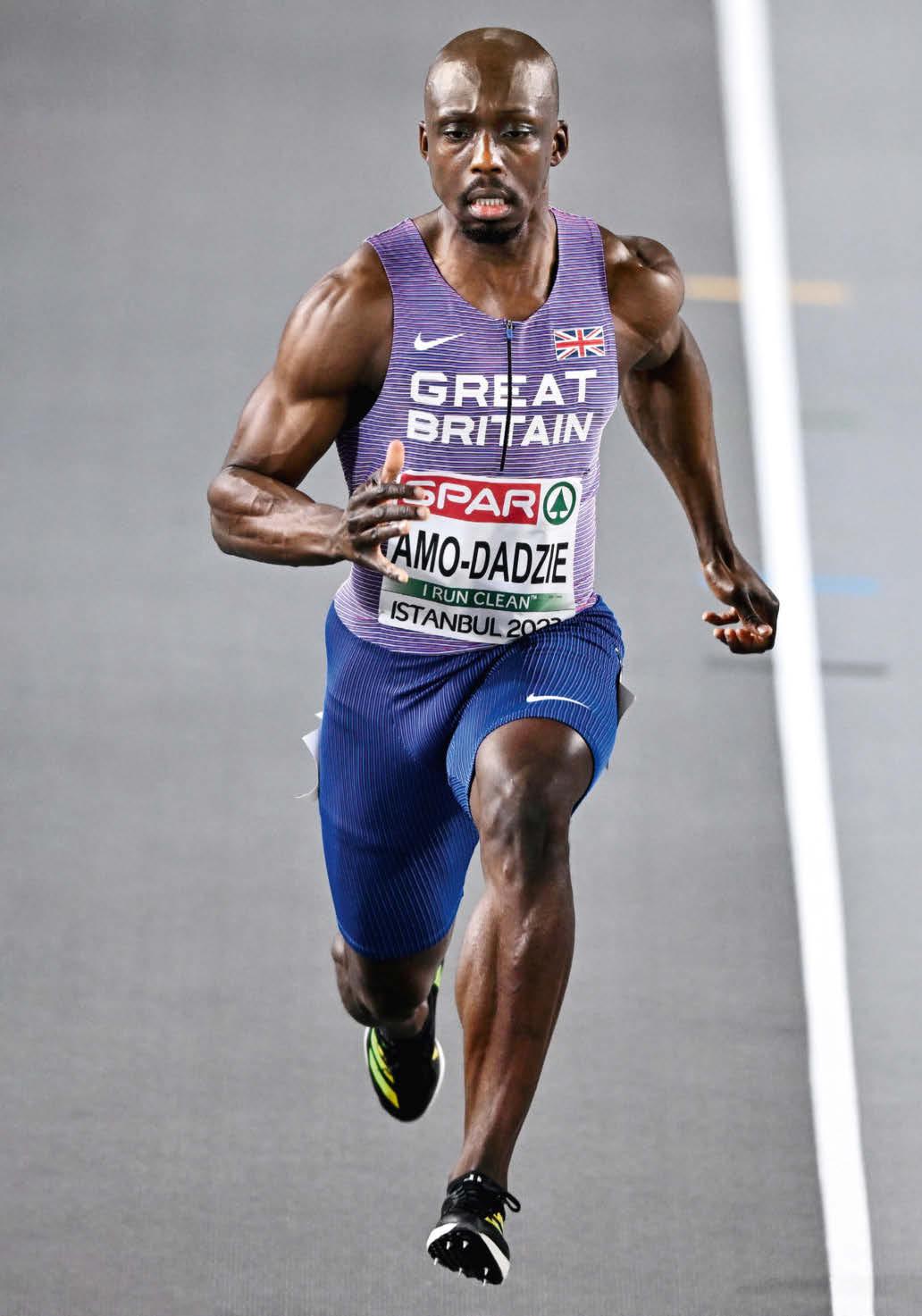
“I looked at the clock and it was like, ‘Wow. I knew it was quick, but not that quick’”
THE RED BULLETIN 29
Eugene Amo-Dadzie: if you think he’s fast on the track, you should see him use a calculator
THE COMEBACK KID
MAX WHITLOCK is the most successful British gymnast ever, with six Olympic medals and a host of other titles. But the 30-year-old would be the first to admit he doesn’t have it all figured out. After a fear of failure saw him walk away from the sport he loves, the journey back has been a lesson in embracing imperfection
 Words TOM WARD
Photography HAMISH BROWN
Words TOM WARD
Photography HAMISH BROWN

31
Return of the Max: Whitlock, photographed for The Red Bulletin at the South Essex Gymnastics Club in Basildon this July
Max Whitlock
ax Whitlock pauses beside the pommel horse in the near-silence of an empty arena at the COVID-stricken Tokyo 2020 Olympics. Fully focused, the Team GB gymnast launches himself up into a handstand before dropping down into ever-faster pivots, every muscle engaged in controlling the weight of his body as he spins. He’s a furry of movement, pitching himself up to hand-walk across the pommel before continuing to rotate, whirl, amaze…
This performance in July 2021 won Whitlock a gold medal and confrmed him as a generational talent. He’d retained his pommel title from Rio 2016 – where he bagged two golds in two hours – to become, with his sixth Olympic medal, the most successful gymnast in British history. His team, his nation, were jubilant. Whitlock, famously stoic, celebrated his triumph with a small smile and a raised fst.
Mark England, Team GB’s chef de mission for Rio, Tokyo and next year’s Games in Paris, says the win elevated Whitlock to “the pinnacle” of his sport. Naturally, he was keen to retain the medallist’s services. “Have you thought about Paris? Come on, if you do it, I’ll do it,” England joked en route to the postcompetition press conference. At 28, Whitlock was one of the more senior athletes competing, but as a giant of British gymnastics it seemed a given he’d want to continue as long as he could. Whitlock wasn’t so sure. “My mindset had always been to continue for as long as I possibly can,” he says. “But that had started to change.”
Whitlock is reliving his time in Tokyo on a sunny July day almost exactly two years after the event. Rather than basking in the glow of yet another Olympic gold, he says, his downtime after Tokyo was dogged by a nagging self-doubt that had been building since a disappointing silver at the Artistic Gymnastics World Championships in Doha, Qatar, in autumn 2018. “That was a year that taught me a lot,” Whitlock says. “Publicly, it was perceived that I had failed because I didn’t get gold. That hit me quite hard. It’s when a fear of failure frst set in.”
This fear had stayed with him, exacerbated by the pressure of lockdowns in the lead-up to the delayed Tokyo Games. “That feeling of retaining [the gold medal] was unbelievable,”
says Whitlock. He means this literally. “When I landed the pommel routine in Tokyo, I remember saying to myself, ‘I cannot believe I’ve just done that,’ because I thought there was a chance I wouldn’t,” he says. “I’m competing against youngsters in their prime. If I fail, if I make a mistake, it’s noted. I felt the most nervous I’ve ever felt in any competition.” Whitlock enjoyed the period immediately after the Olympics: “For the frst three months, it felt like freedom; no ties, no training.” But as time went on, he felt that now-familiar weight of expectation return to his shoulders. “Every year that goes by, the sport becomes harder,” Whitlock says. “That fed into a fear of looking forward and wondering what will happen if I don’t achieve more targets. Then it just hit me. Suddenly I was adamant I was fnished with the sport. I was done.”
Today, at the South Essex Gymnastics Club in Basildon, Whitlock looks far from fnished. As he rises to return to the pommel horse, his hands coated in chalk mixed with maple syrup for grip, he looks calm and capable. After 23 years in the sport, gymnastics has shaped him mentally and physically. Despite extreme shyness as a child – he couldn’t even buy his own sweets at the shop – a 12-year-old Whitlock mustered the wherewithal to move to Slovenia for gymnastics. He petitioned his parents to let him leave his hometown of Hemel Hempstead to train with coach Klemen Bedenik in Maribor. Bedenik had been so impressed by Whitlock’s talent at the age of seven – partly thanks to strength he’d built in the pool as a swimmer before discovering gymnastics – that he’d made space for the youngster on his roster at Hemel Hempstead club Sapphire Gymnastics. Now Whitlock couldn’t see a future in the sport without him.
He issued an ultimatum: either he moved to Slovenia with Bedenik or he gave up gymnastics. Begrudgingly, his parents gave their consent. So Whitlock moved in with Bedenik and his family. As well as training, he attended school, where he would arrive an hour early to learn Slovenian before normal lessons began. It was demanding, but, reasoned Whitlock, gymnastics was worth it. “That constant, rewarding feeling of learning something new is unbelievable,” he says. “The achievement of doing even one new skill is amazing, you get such a buzz. I wanted to keep it up, and [relocating] was the way I could.”
The move lasted just three months as Whitlock’s parents felt the strain of their young son living more than 1,500km away. To tempt her son back, Whitlock’s mother sought out the services
32 THE RED BULLETIN
“I remember sitting feeling like a waste of space. I was lost”
Finding balance: the gymnast has experienced both the positive and negative effects of the pressure to succeed

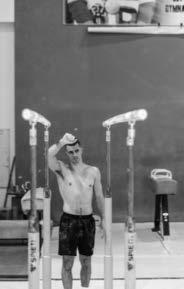




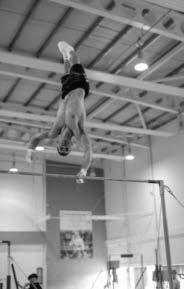



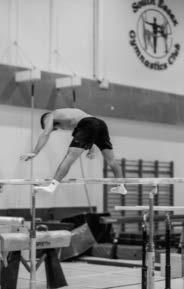
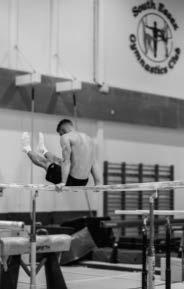


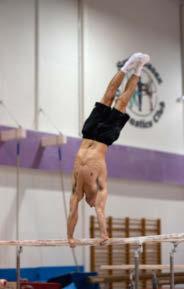
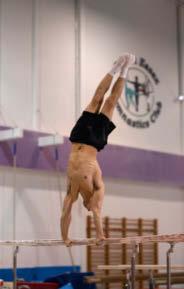
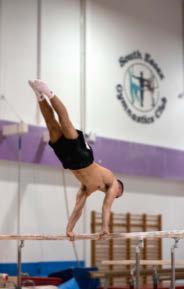



34 THE RED BULLETIN
Big returns: Whitlock was back to his best after just a couple of training sessions; (opposite) with coach Scott Hann at Tokyo 2020
of Scott Hann, a British coach with a proven track record, who lived a comparatively local three-hour round trip from the family home. So began almost a decade of multiple weekly trips to the South Essex Gymnastics Club where Whitlock trains today – a cavern of pommel horses, high bars and foam pits inside a public sports club where Hann is director of coaching.
Before Whitlock relocated to Upminster in 2014, Hann described his constant commuting as “a crazy commitment”. But the coach estimates only two per cent of athletes have a chance of competing at a professional level; gymnastics is an unforgiving sport for all but the most dedicated. It’s often described as the world’s toughest sport, and with good reason – the sheer number of moving parts can be dazzling as athletes work to hone multiple skills: strength, agility, power, fexibility, speed, unwavering mental focus. “There are so many different skills and variations within gymnastics, and you might teach them 10 different ways depending on the physicality of the athlete,” says the affable Hann, 42, a former gymnast himself. “In any given routine, there are 10 elements. There are six different pieces of apparatus, so that’s 10 skills each, each of which can be taught 10 different ways.”

To keep up, Whitlock was training six days a week, for up to 35 hours, as well as attending school. “It was tricky [balancing school and gymnastics],” he says. “I did feel busy compared with most school-age kids, but I also felt lucky to be doing what I was doing. I just loved being a part of the sport.”
His efforts were paying off, with Hann describing him as “light years away from anybody else”. Whitlock made the decision to leave education after secondary school to focus solely on his sport. The titles began to stack up; he won gold on the pommel horse and foor at the 2010 Junior European Championships, earning a second-place fnish in the all-around – the highest combined score across all six events.
The same year, he travelled to the Commonwealth Games in Delhi as part of the team that won silver in the men’s artistic all-around team event. He continued to win medals at world
and European championships, bagging his frst two Olympic honours – both bronze – at London 2012 for the pommel horse and all-around. By the time Tokyo 2020 came around, Whitlock had decided to focus his training on the former. He would still compete in the foor exercise – he’d won gold at Rio 2016 – but it wouldn’t be his main focus. He ended up taking gold in both. Medals aside, it was clear to those around Whitlock that they were in the presence of a unique athlete. “People are practising, say, 50 routines a week, [but] Max is doing almost 150, just going over and over every skill,” says Courtney Tulloch, a specialist in rings and vault who took bronze at the 2022 World Championships and also trains under Hann in Basildon. “That’s why the [skill] gap is massive. It’s incredible.”
Whitlock remembers struggling with a squat landing from the high bar. Rather than aim for one perfect landing, he decided he needed to do six in a row, and he didn’t leave the gym until he’d nailed it. “It’s more effcient,” he says, matter-of-factly. “They talk about 10,000 hours [to become an expert in something]. I must have done 30,000 hours. My whole life I’ve just wanted to see how far I can push it. Whenever I’ve come back after a break, I want new routines, to push the bar again. Then, when I go to a competition, I have no choice but to do the biggest routine I can.”
For Hann, it’s this desire to focus on the most diffcult moves that sets Whitlock apart. In gymnastics, skills are rated by letter, starting with A. Hann says most people go for one or two Ds and Es, but mostly stay on safe ground with Cs; Whitlock aims for Ds and Es in almost everything. During the foor exercise in Tokyo, Whitlock incorporated an ‘air fair’ in which an athlete rotates their body vertically while also travelling in a circle along the foor. “It’s so ambitious,” says Hann. “It’s so diffcult that even if it’s not perfect, it’s really impressive.”
There’s also pressure to peak at the right time. As well as the World Championships in autumn, there’s the European Championships in April, with qualifcations beforehand. The Olympic and Commonwealth cycles eat up any remaining free time. “It’s day in, day out,” says Tulloch, who hasn’t taken more than 10 days off in a row since the age of seven.
Whitlock proved time and again that he had the rare ability to perform some of the most demanding routines under pressure in front of large crowds. “From a young age, I had this mature mindset where I go with the fow and don’t take things in too much, be they good or bad,” Whitlock says of his rise. “I never let results go to my head, which helped me stay levelheaded.” Hann sees this reserved nature as a strength in competition: “As a person, Max is calm, methodical. He’s very introverted, and I think that helps him stay calm under pressure.”
As each gold medal raised the stakes, privately Whitlock was starting to falter for the frst time. When he quietly announced his retirement a few months after the Tokyo Olympics, the reality of the weight he’d been carrying hit him “like a ton of bricks”, he says. “I realised how physically and mentally straining it was, just being on 24/7. You have to be switched on all the time.”
It’s only relatively recently that mental health in sport has become openly discussed, with high-profle athletes including tennis ace Naomi Osaka, England cricket captain Ben Stokes and footballer Dele Alli among those speaking out about their struggles. Talking to The Times during Tokyo 2020, Whitlock voiced his support when Simone Biles, a young medal-hopeful gymnast on the US team, temporarily dropped out of the competition, citing mental health concerns. “When
Max Whitlock
“In Tokyo, I was the most nervous I’ve felt in a competition”
THE RED BULLETIN 35 GETTY IMAGES

“If I still feel like I’ve got more to give after Paris 2024, I don’t think LA 2028 is off the cards”
Max Whitlock

37
you’re doing the types of moves Simone is doing it becomes so dangerous,” Whitlock said. “[She] made a lot of people think twice about [the] sport.”
It took time for the Team GB gymnast to discuss his own mental health struggles. “I was trying to make myself feel like, ‘Yeah, I’m content. I’ve done more than I could have ever dreamed of in the sport,’” Whitlock says of his retirement. “I miss my family massively when I’m away. [Initially] being back was great.”

At home in Upminster, his four-year-old daughter was practising her own gymnastics routine on a mini beam. Whitlock kept himself occupied working on an app for gymnastics coaches, and a grassroots programme to attract young people into the sport. But with no personal sporting goals for the frst time in his adult life, a different reality began to hit home. Whitlock felt unmotivated, sluggish. He couldn’t get out of bed.
“Gymnastics is all I’ve known for 20 years,” he says. “[Leaving] was a total switch. As a gymnast, you have short-, mediumand long-term targets, with a complete achievement pathway. [That lack of purpose] is really, really tough.”
What Whitlock had seen as an escape route began to feel like a dead end. “When I looked to the future, I couldn’t see clearly what I wanted to do, and I remember just sitting there feeling like a waste of space. I was lost. I didn’t have a plan. I wasn’t eating well. I wasn’t exercising at all. [I felt like] a failure.”
After months of suffering alone, Whitlock did something he never thought he would: nervously, he opened up to his wife Leah. “I’d never [spoken about my mental health] before,” he says. “I saw it as a sign of weakness.” It was torturous to begin with; the frst time he spoke to his family, he struggled to get the words out. “I couldn’t even comprehend what I was feeling, but the more I spoke and used my family as a sounding board, the more I could understand it.”
It was clear he needed a goal, but when Leah suggested he get back in the gym he was reluctant at frst. Recovery was a slow process. Whitlock didn’t speak to a therapist, but he says that sharing his feelings with his family over a period of months helped him to deal with the issues that had pushed him into retirement. He began to regain some of the fght that had seen him achieve so much. “I realised I didn’t want to stop because
“I feel like everything I do now is a bonus, so I can just give it my all”
38 THE RED BULLETIN
Shining example: the most successful British gymnast ever shows off his Olympic medal haul
of the fear of failure,” he says. “I would hate it if in ten years’ time my daughter asked why I didn’t go to Paris. I’d have to say, ‘I was scared of not achieving what I was expected to.’ That’s such a bad message. It feels like a coward’s way out.”
Finally, after more than a year away from the gym, Whitlock reached out to Hann: he was coming back.
Whitlock mounts the pommel horse, twists, turns, winces. He drops to his feet, walks off, catches his breath. He holds out his hands, showing sizeable blisters and grazes. “Just little ones,” he says. Then he goes again.
Blisters aside, today at the South Essex Gymnastics Club a post-retirement Whitlock is clearly enjoying himself. Sporting a crop of dark hair and a ready smile, the 30-year-old retains a boyish look, which, combined with his air of reserved calm, makes it easy to imagine the shy 12-year-old who frst entered this gym in 2005.
“When Max said that he was coming back, I warned him that it would be diffcult,” explains Hann. “But I could see that he needed that purpose. Once he had that, it was so nice to see him smiling again.”
Whitlock has approached his return in a relaxed manner, gradually ramping up his training. “That frst session [back] was an hour or two, maximum,” he says. “It was just light stretching and being in the environment again. It was going in with a fresh mindset, and I loved every minute of it, slowly working towards competing again. I didn’t feel nervous. [In the end] it wasn’t this big thing – I was just excited to be back around my teammates.”
Not one to do things by halves, Whitlock now has his sights set on competing at Paris 2024. He’s preparing routines on the pommel horse, the demanding apparatus that has already won
him three Olympic medals; the parallel bars, another serious test of strength with routines incorporating handstands and backfips; and the high bar, on which gymnasts complete acrobatic 360° rotations. Taking his age into account, Whitlock has devised a brand-new routine for the pommel that is shorter and less demanding – but which still has medal potential.
Watching his friend’s return, Tulloch has been amazed. “The amount of time he had off, it would take anyone else a year or two to build it back,” he says. “Within one or two sessions, Max was doing the skills he was doing at the Olympics. I would say that’s almost impossible, but for him it’s normal.”
Having faced losing the sport that defnes him, Whitlock feels he’s now in a stronger place. “[I had a] reset and came back a refreshed, younger version of myself,” he says. “The fear of failure has almost disappeared, because I feel like everything I do now is a bonus, so I can go out and give it my all.”
On social media, the gymnast now shares the bad days as well as the good; he’s comfortable opening up about the oftendisappointing sessions he must endure to achieve the polished routines that have made his name. “People look at me and think I’ve got it all fgured out, and I defnitely don’t,” he said on his YouTube channel shortly after his return. “I’ve only ever showed what I’ve done [perfectly, on social media]. Now, if I have a bad session, I’ve changed my mindset – it’s the process that’s important. I’m excited to give more of an insight, to show the reality of it.”
Hann says Whitlock’s openness has inspired countless other athletes. “Coaches and gymnasts are very keen to push themselves,” says Hann. “But you’ve got to have that balance and that awareness of when enough is enough.” A lot of Hann’s work is now focused on fnding an equilibrium between athlete performance and mental wellbeing. Tulloch says team psychiatrists are much more visible in and around training sessions, and it helps him to talk after a diffcult day.
Should Whitlock win a place on the podium in the pommel in Paris, he’ll become the frst gymnast in history to bag four consecutive medals on the same apparatus. But Whitlock feels he has nothing to prove to anyone but himself. “My whole journey has been to see where I can take it for myself,” he says. “Twenty years down the line, I don’t want to think, ‘What if I’d tried for another couple of years? What would I have done?’ I want to see what my full potential is.”
Whitlock’s frst major post-retirement competition will be the Artistic Gymnastics World Championships in Antwerp in late September/early October. And beyond that? “It’d be easy for me to say it’s a fnal push to Paris then I’m done,” he admits. “But I’d be lying. I’ll take it year by year. If I still feel like I’ve got more to give after Paris, I don’t think Los Angeles [in 2028] is off the cards. If I could make it fve Olympic Games, why wouldn’t I try?”
And with that, Whitlock is back on the pommel horse, blisters and all, spinning ever faster.
Instagram: @maxwhitlock

Max Whitlock
“I had a reset and came back a younger version of myself”
THE RED BULLETIN 39 GETTY IMAGES
Solid gold: celebrating his pommel win at Tokyo 2020
TRAILBLAZERS
Every year, RED BULL HARDLINE attracts the world’s top downhill mountain bikers – and yet no woman has nailed its wildly challenging course. Six elite female riders, including World Cup champ Tahnée Seagrave, visited the Welsh mountains intent on changing that
 Words JESSICA
HOLLAND P hotography SAMANTHA SASKIA DUGON
Words JESSICA
HOLLAND P hotography SAMANTHA SASKIA DUGON

41
Taking the lead: Tahnée Seagrave, photographed for The Red Bulletin at the Red Bull Hardline course in the Dyfi Valley, Wales, in July this year
Hard act to follow:
Seagrave takes a brief moment to reflect on the Progression Group’s achievements at the course; (opposite) saddled up and raring to go

42 THE RED BULLETIN
Three of the world’s best mountain bike riders are rattling up the slopes of a Welsh mountainside in a rickety Land Rover, looking nervous. Tahnée Seagrave, Louise Ferguson and Jess Blewitt are accustomed to the adrenaline and risk of downhill racing: Seagrave has eight World Cup wins to her name; the other two have enjoyed recent victories at the epic Crankworx race in New Zealand. But what they’re about to try today is a course carved out of the hillside for Red Bull Hardline, a competition that pushes still further the boundaries of what’s possible on two wheels. There are jumps of almost 30m, hairpin turns, slippery slabs, hazardous rocks and roots, narrow landings that can’t be spotted until the very last minute, dangerous levels of wind exposure, and not a moment of smooth riding to catch a breath in between.
No woman has ever completed a full run of Red Bull Hardline. Blewitt tried last year, alongside male competitors, and broke her collarbone flying off a steel motocross ramp to cross a 14m gap that must be approached at 65kph. And now the drizzle that’s been dampening spirits all morning has become a downpour, adding yet another level of danger.
It’s Seagrave, dressed in a neon-pink jacket, with her blonde hair pulled back, who has assembled the group of elite women riders to attempt this fiendish challenge. A phenomenal athlete, the Brit has been riding since she was nine, having relocated with her family to a mountain biking hotspot in the French Alps a year earlier (she would return to the UK in adulthood). Younger brother Kaos is also a pro rider and regular Red Bull Hardline competitor. Yet, even with this background, Seagrave, now 28, feels the frustrations of being a female rider growing up with fewer role models and less sense of possibility than male peers.
“We live in a man’s world, don’t we?” she says. “This is a male-dominated sport. I know there’s a lack of opportunities for women, so it’s my priority to push for that.” She set up the Progression Camp with Red Bull’s help, not to put pressure on anyone to complete the course but to plant seeds for the future. “The goal is just to eventually get a woman to do topto-bottom. I don’t think we really care who; we just want it to happen.”
For this reason, Seagrave invited to the camp not just downhill racers – riders who are used to steeling their nerves as

Red Bull Hardline
THE RED BULLETIN 43
Red Bull Hardline

they rocket down muddy mountainsides – but also three pro freeriders. Crammed into a 4x4 behind ours are American Hannah Bergemann, Argentinian Cami Nogueira and New Zealander Vinny Armstrong – riders used to collaboratively figuring out how to tackle gnarly trails and big airs. Their discipline rewards daring and style rather than speed. Still, like the others, this is a big step up from anything they’ve attempted before. Even three-time Red Bull Hardline winner Bernard Kerr, tagging along for guidance and support, admits privately that he’s scared to ride in these conditions.

The hills of southern Snowdonia, saturated by a grey blanket of rain, pass by the Land Rover’s windows as it strains up the unpaved track to the mountain’s summit. Tomorrow, a group of 30 male invitees will arrive to start practising on the course, ahead of the final race at the end of the week. Today, the track belongs to this group of women – a local village hotel their base camp –who’ll be testing the limits of what can be achieved. As they get on their bikes, surrounded by a posse of filmers and mechanics, and start pedalling towards the start line, that’s a daunting prospect.
Blewitt hasn’t been back on these slopes since the crash that cracked her clavicle, and Seagrave has barely recovered from a series of life-altering injuries over the past few years, which culminated in a debilitating concussion that left her unable to ride for nine months. “I’m not the same person I was when I won all those World Cups or when I’d trust my instincts,” she says. “My brain’s not the same, so overcoming fear feels new.”
Within an hour of taking to the course, there are both crashes and victories. The first big challenge is an off-camber rock slab that points riders in the direction of a sheer drop if the riders slip. Ferguson, 27, who began her career in the Scottish Highlands before moving to New Zealand, is the first to tentatively roll down it, successfully catch the dirt berm on the other side and disappear into the gloom of the dripping pine forest. Soon after, Nogueira sends a step-down into a tight turn with too much speed, smashes into a tree and cracks her frame. Luckily, she’s unhurt – if you don’t count a huge, bleeding scrape on her thigh. Ferguson doesn’t, laughing as she peels down her leggings to check it out. A phone call later, fresh bike parts are being shipped from London to rural Wales.
“I’ve got no doubt there are women who can do a full run”
44 THE RED BULLETIN
Louise Ferguson
Ferguson also gets away with casing a landing on the Cannon, which shoots riders out of a patch of woodland and over a 17m gap. She doesn’t pull up her bike enough in the air, and the impact of her back tyre catching the lip of the landing strip blows out her inner tube. Still, just seeing her send the jump is a rush for the other riders. Dan Atherton, who built the Red Bull Hardline course almost a decade ago, has described the Cannon as “the most scary jump on the track”. Not only is there wind exposure

and a tricky run-in, but the curved landing, on the edge of a hillside, doesn’t allow much freedom to overshoot: “The room for error is pretty much zero.”
Seagrave has been absorbing all this action methodically, gauging how fast Ferguson hit the jump and how much Kerr pulls up his bike in the air during his demonstration. She asks him to ride behind her and assess her speed as she rides the twisted section that leads to the Cannon, stopping abruptly just before she’s shot out into the air. The biggest
jumps in downhill racing are around half the size of this, and it’s only been a couple of months since Seagrave began riding again regularly after her concussion.
In the early days of her injury, she suffered intense anxiety, depression, brain fog, dizziness and nausea. “My whole world fell apart,” Seagrave says. “I felt like I was drowning, like I was an alien in my skin. For weeks, all I could really focus on was breathing. I’d meditate for five minutes at a time and that was the only time when I felt I was doing
THE RED BULLETIN 45
Aiming high: (above) Seagrave overcomes any apprehension and launches into a jump; (opposite) thanks to the efforts of downhill MTB stars such as Seagrave (left) and Blewitt, one day women riders will be on the podium at Hardline

 Fine line: (from top) Ferguson (left) and Bergemann are blown away by the course; Blewitt goes again after last year’s crash
Fine line: (from top) Ferguson (left) and Bergemann are blown away by the course; Blewitt goes again after last year’s crash
something. I couldn’t take it day by day; it was minute by minute. It was so scary.” The first time she could stand up long enough to make a cup of tea was a milestone. Then there was her first complete lap around the outside of her house. She returned to World Cup racing in June, just a month before this trip to Red Bull Hardline, but was expecting her role here to be more about supporting the others and less about attempting the course’s killer features herself.
When she starts hurtling towards the Cannon again a few minutes later, those watching assume this is another chance to practise the run-in. But something changes in her bearing as she rattles around a hairpin bend, and there’s an acceleration as her tyres churn through the mud. This time, Seagrave doesn’t slam to a halt before the jump but sends herself off it. No one breathes during the moment she’s airborne. When she cleanly hits the landing about 18m away, there are screams of elation from the whole gang, and tears in Seagrave’s eyes.
“That’s the mindset I’ve been looking for since my concussion,” she says later, once riding is done for the day and she has returned to the Athletes’ Area – a zone at the bottom of the course that offers a chill-out tent with food and a TV, as well as the team pits and a place to wash muddy frames and tyres. “It felt amazing. I was embarrassed that I got so emotional, but it wasn’t just about that jump; it was about the past four years of injuries. Suddenly all those hardships melted away and I was able to get to that point in my brain where I could switch off and do something scary again.
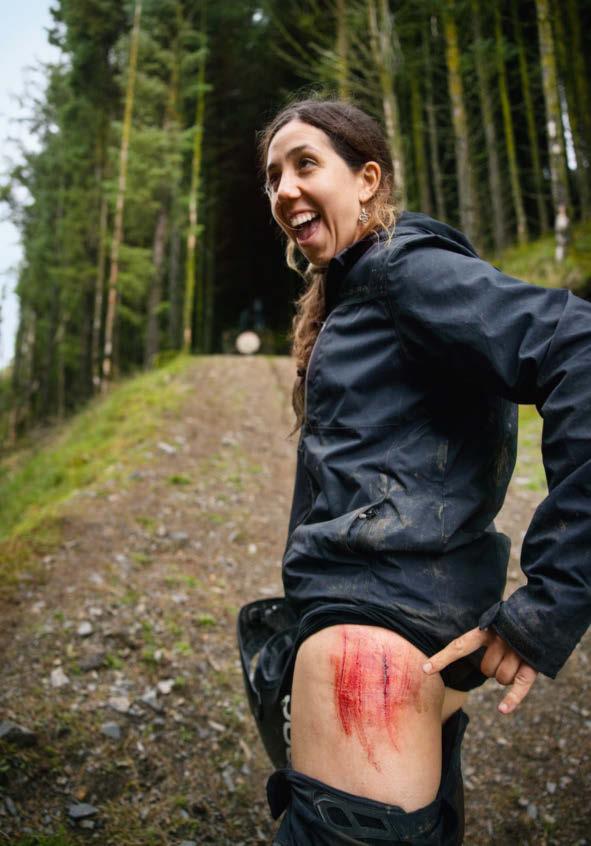
“I’ve never approached a jump that fast and pulled that hard in my whole life. I don’t do big airs, so I don’t know what it’s like to be in the air for that long. It just felt insane. And I landed it and didn’t injure myself. I’m so proud of myself already. This isn’t just a milestone after my crash; it’s a huge milestone for anyone.”
It was the supportive atmosphere – and seeing the other women face their fears – that helped push Seagrave to test her limits, she says. These are luxuries that Blewitt didn’t have last year when she was the only female rider amid a sea of men. “Jess is so brave,” Ferguson says as she waits to rinse off her bike at the end of the day. “I can’t imagine going up there like we did today, but being alone. I think I would have struggled. The men are really supportive at World Cups, and I’m sure everyone’s really nice here as well, but it’s intimidating being around male riders. They’re physically different and have a different experience
racing and riding around other men, whereas we can relate to each other and help each other.”
Research led by Dr Fiona Spotswood, an associate professor in marketing and consumption at the University of Bristol and a keen cyclist herself, shows that Ferguson isn’t alone in these views. Men count for roughly four out of every five mountain bike riders at every level, Dr Spotswood reports, and the women who do take it up “are generally introduced to the sport by men and then ride with men”. When they find other women to ride with, she says, “they often
Red Bull Hardline
“We don’t want things made easier for us”
Tahnée Seagrave
THE RED BULLETIN 47
Scraping together: Nogueria shows off her battle scars following a collision with a tree
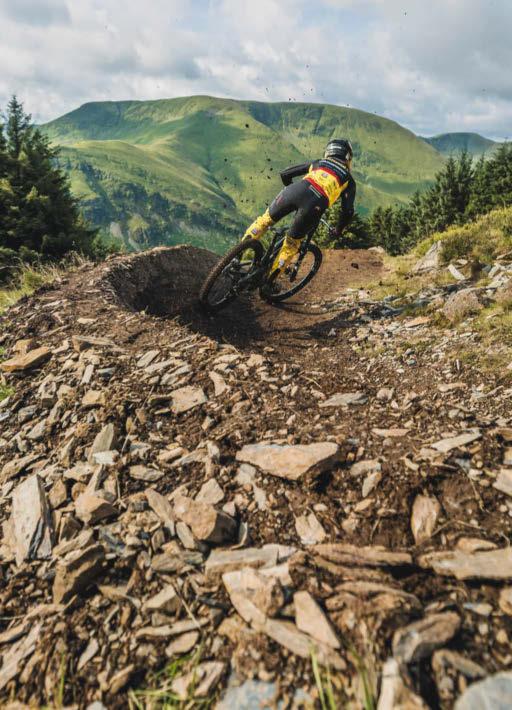
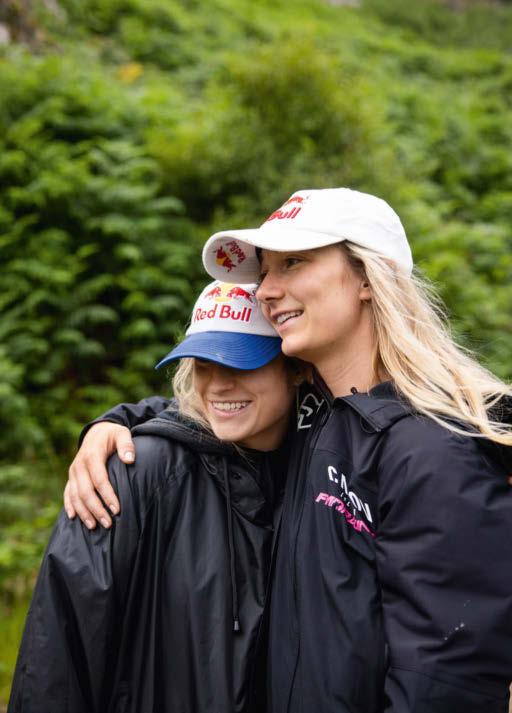


48 THE RED BULLETIN
Staying the course: (clockwise from top left) Ferguson in flight; “This isn’t about us; it’s about the future,” says Seagrave, pictured (right) with Blewitt; Ferguson was only a last-minute addition to the group but now looks forward to returning next year; New Zealander Armstrong is a talented pro freerider
progress much quicker, because they feel more comfortable. In a mixed space they are being left behind, or feel on edge. This isn’t because any man or group of men is making women feel uncomfortable on purpose. It’s just that there is a gender dynamic in action sports which you can’t avoid”.
The reason behind this is discussed in a PolicyBristol report published by Dr Spotswood and colleagues in March this year. The researchers found that when women are “socialised into a maledominated and masculine culture, their own experiences and ways of engaging can feel invalidated”. Having only men as teachers, role models and riding buddies “creates pressure and exacerbates feelings of imposter syndrome, fear and anxiety”.
According to Dr Spotswood, the solution isn’t “treating everyone the same” – an idea that one brand rep she recently interviewed kept proudly repeating. “You have to treat us differently in order to foster equality,” she says, “because women have a different socio-political history to men. They have a different relationship with the sport, different barriers.” Instead, she recommends raising female visibility within mountain biking, and linking up women so that they can ride together.
The women’s Progression Camp ticks both boxes. “It’s about providing this group of girls with the tools and the environment to thrive and have fun,” says Seagrave. “Then young girls watching us might be inspired to think, ‘One day I could probably do Red Bull Hardline.’ We’re not in a rush to get it done, but if there’s anyone in the future that can, that’s amazing. We just know it’s possible.”
Seagrave knew she didn’t want to create a “watered-down” version of Red Bull Hardline: “There’s such a stigma that if a girl does something, it must be easy. We don’t want things to be made easier for us. We’re quite happy walking paths if it’s too hard. But we want to try, and we want to do it alongside the men.”
Due to the wild and windy weather, there’s only time for one proper women’s-only session on the Red Bull Hardline course before the 30 male competitors join them on the track the next day. This shifts the energy into a different gear. It means more eyes, more pressure, and more queuing for a turn on the track, but the women stick together and urge each other on. “Sometimes you
have to rely on each other to get through it,” Bergemann says later. It’s an approach she’s familiar with in the freeriding world. “You can’t do it on your own.”
Together, the group complete one section after another, with male riders shouting out encouragement and demonstrating jumps. Ferguson’s the only woman to tackle a new on-off feature called the Lily Pad, flying over two 12m gaps in a row with just a short strip in between. She’s even ready to go for the infamous Road Gap, a 17m send over a fire-access road, and has spent a sleepless night watching POV videos and visualising sending it – but the weather turns again before she gets the chance.
That could have been a blessing in disguise, Ferguson admits later. The same day, Blewitt goes flying off a huge step-down with a 18m gap, a 12m vertical drop, and a dirt landing that’s almost impossible to see until you’re in the air. When she hits the other side, it looks clean, and there’s a big cheer from all the riders lining the track, but her ankle absorbs too much of the impact. As Blewitt rolls to a stop, she shouts for help, unable to unclip from her pedals, and falls to the ground.
“It was so unfortunate,” Seagrave says later. “That feature has such a harsh landing, and she didn’t do anything wrong. It was a reality check for me because we were buzzing and ticking off features, and everything felt so amazing. Your adrenaline’s peaking, and then all of a sudden you remember this is actually really dangerous and shit can go wrong pretty fast. I didn’t ride much after that.”
The following day, Blewitt is getting scans – it transpires that her ankle is fractured and she probably won’t be able to ride again until autumn – as the other five women riders gather in a pub to talk to the press. There’s now a proper storm raging outside, with rain lashing the windows, so riding is cancelled for
the rest of the week. Despite this, spirits remain high. “We’re so ecstatic for each other and what we’ve achieved,” says Seagrave. “Yeah, we’re greedy and we do want more, but what we’ve done so far is amazing.” Ferguson recalls how intimidated she felt when the men joined them on the mountain, “but then Tahnée dropped in first in front of everyone and made them move out of the way. That set the tone. We went down the hill as a group, with everyone helping. It felt like a community thing, everyone cheering each other on”.
When Seagrave first asked her to join the group, filling in for another rider who’d dropped out last-minute, Ferguson had been hesitant, saying she wasn’t sure she could ride a single feature. Seagrave replied that she felt the same way. Now, everyone here is saying that they’ll return next year, and they’re discussing how to up their training in preparation. “My mindset about Hardline has completely changed,” Ferguson says. “I’ve got no doubt that there are women who can do a full run. It’s just a case of how and when we can make it happen.” Armstrong agrees: “It’s clear that women want to do it, and that they can do it. It’s possible, so it needs to happen.”
Creating the conditions for women to compete at the same level as men is a Herculean task, and Seagrave is well aware that it won’t happen overnight. But if there’s one thing she has learnt from her experience with concussion, it’s patience: “A lot of ego got dropped from me. I’m so grateful for that.” She used to get annoyed at the additional obstacles in the way of female riders, but now she has a more pragmatic perspective. “We can only focus on what we do best, and I’m just going to try to encourage women as much as possible to get out there and do what they want,” Seagrave says. There are a lot of people who want to see us succeed, but it’ll take time, and I’m willing to put in a lot of time.
“Rome wasn’t built in a day, and these boys definitely weren’t built in a day. They had nine years of experience at Hardline that we haven’t had, all these opportunities beforehand, and people to look up to when they were younger. Hopefully, when women see us here, the field will expand, and so will the talent. This isn’t about us; it’s about the future.” To watch highlights of Seagrave and co in action at the Red Bull Hardline 2023 Progression Camp, go to redbull.com
Bull Hardline
Red
THE RED BULLETIN 49
“Girls watching us might think, ‘One day I could do Hardline’” Tahnée Seagrave
FOR THE ONLY GOLD THAT MATTERS
The latest BoXXer was designed for a new era of downhill race performance. Winning World Championships and World Cup Overall titles under the BlackBox name, BoXXer offers a clear, proven advantage over the competition. For the only gold that matters on race day, BoXXer delivers.
ROCKSHOX.COM
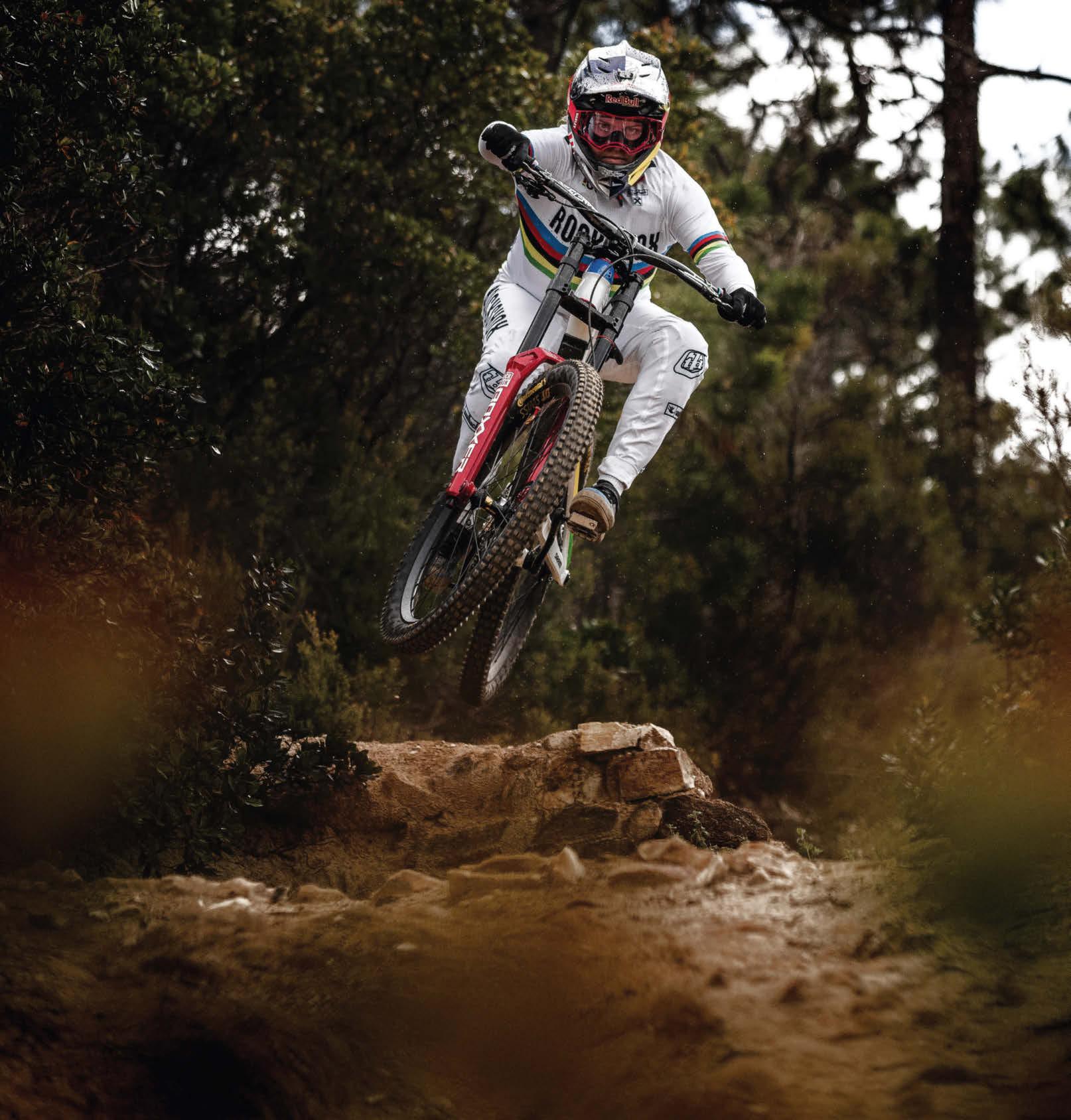
NEW BO XX ER
©2023 SRAM LLC


is born 2004 BoXXer goes to 200mm travel 2009 BoXXer gets 35mm tubes A guy named Steve becomes w orld champ in 2009 2014 the first BoXXer with 27.5 wheels 2019 World Championship in Les Gets 2001 Vali is born 2018 Vali wins her first Jr Downhill World Cup 2019 Vali becomes the JR World Champion 2022 Vali wins Elite DH World
 Northern exposure: Bad Boy Chiller Crew, photographed for The Red Bulletin at the O2 Academy Leeds in May this year
Northern exposure: Bad Boy Chiller Crew, photographed for The Red Bulletin at the O2 Academy Leeds in May this year
Behind the bassline
Pranks, prison stretches and pumping tracks. For the protagonists of Bradford’s thriving underground scene, it’s about more than music; it’s an escape. To a better life, perhaps, but never far from the community they love

YUSHY 53
Words ALICE AUSTIN Photography
ad Boy Chiller Crew walk on stage like they’re entering their own living room. They greet fans with the ease and familiarity of old mates, which in many cases they are. Clive’s signature mullet pokes out of the top of his giant parka, GK’s white shirt matches his Cheshire Cat grin, and Kane displays dark shades and gun fingers. The crowd bellows along to their opening track, Get Out My Head from the 2021 EP Charva Anthems, and when the chorus kicks in, fireworks and string confetti fill the air, making O2 Academy Leeds look like it’s just been teepeed.
“Oggy oggy oggy!” calls GK.
“Oi oi oi!” responds Leeds.
The Bradford bassline collective is on a rampage. In 2019, The Guardian named Bad Boy Chiller Crew one of its ‘50 new artists for 2020’. Esteemed New York Times music critic Jon Caramanica included their second album, Disrespectful, in his top 10 albums of 2022. And this year they were shortlisted for a BRIT Award for Group of the Year. Here in Leeds, they’re kickstarting their biggest tour to date, designed to build maximum hype ahead of the release of their third studio album, Influential
BAn impressive trajectory for a career launched on Facebook, Instagram and TikTok, where the subject material was, and still is, far from wholesome.
Google will tell you it started around 2017, when Gareth ‘GK’ Kelly, Kane Welsh and Sam ‘Clive’ Robinson began posting Jackass-style comedy skits and sketches on social media, but kids in Bradford have been pulling stunts like this for decades. BBCC were just the only ones brave (or reckless) enough to share them with the public.
The trio’s videos aren’t for the faint-hearted –vodka bongs, paintball fights and self-proclaimed crackheads all make recurring appearances – but their energy, humour and general lunacy hit a cultural nerve. Young people in Bradford lapped it up, seeing a reflection of themselves, their mates and their humour in the public domain for the first time.
BBCC began MCing as a joke while working day jobs – Welsh and Robinson were packing boxes in a warehouse; Kelly was driving an ice-cream van – but were inspired by bassline music from the late ’90s and early 2000s. Bassline is a Yorkshire-specific brand of garage with chopped-up vocals, donking bass and the playfulness of pop. The genre’s birth can be traced back to Niche nightclub in Sheffield, where DJs layered garage tracks with melodic house music. As grime and dubstep gripped the UK’s South, DJs in Yorkshire began removing vocal samples and replacing them with breaks and basslines that MCs rapped over. It became a brand of music unique to the region and turned MCs and producers such as 1st Born, Big Ang, Mr Virgo, J69, DJ Veteran and DJ Q into cult heroes.

In 1998, Bradford’s first after-hours venue, Boilerhouse, launched a bassline club night that
Crew cuts: (above)
BBCC’s Welsh and Robinson spit bars at the O2 Academy; (opposite, clockwise from top) “They’re sick bastards” – fans explain the appeal of the Crew; lights out for Don’t You Worry About Me; a buckethat salute; punters queued around the block for hours ahead of the show; BBCC merch is as low-key as the trio themselves
Bassline
54 THE RED BULLETIN





made such an impact it still shapes the collective music taste of the city. Now, the people who went to that club night are parents, and their kids haven’t just inherited their love of bassline but are actively continuing its legacy, spurring a revival that began in the late 2010s. And BBCC are leading that charge.
A young woman with hornet-stung lips drags on a Richmond cigarette in the smoking area as BBCC’s bassline remix of Cher’s Believe bleeds through the doors. “All Northern children, including them, were brought up in the kitchen,” she says. “Our mums would bring us to the pub cos no one can afford a babysitter. Us kids would play in a corner, then we’d go back to someone’s kitchen for the after-party.”
“That’s what it’s like in the North,” interjects her mate, who has inch-long eyelashes. “Their mums are the same. That’s just how it is round here.”
Bradford is the UK’s youngest city – 29 per cent of the population is under 20 and nearly a quarter under 16. But there isn’t a whole lot for them to do. The district is among the top 30 most income-deprived in England, and figures from last year show that more than 35 per cent of children in Bradford are living in poverty. In many ways, bassline is a lifeline.

Bad Boy Chiller Crew might be the biggest name on Bradford’s campus, but there’s a legion of local MCs and producers biting at their heels. S Dog is one of them. He tells The Red Bulletin to meet him at BD7, which we assume is a venue but turns out to be a postcode. He rolls up in a Land Rover, which stops outside a chicken shop called Salah’s. Telling the driver he’ll see him later, S Dog hops out. Wearing a black North Face fisherman’s hat, a Champion
jacket, Nike tracksuit bottoms and Nike trainers, he doesn’t walk so much as swagger with the air of someone who owns the place, which he essentially does. When our photographer puts his camera bag down to take photos, S Dog says reassuringly, “Don’t worry, no one will take it. You’re with us.”
The MC speaks like he raps – in short, clipped sentences – and although you certainly wouldn’t want to cross him, he has a bright and disarming smile. “Music for me were just a joke at first,” he says, chatting on a bench in Bradford’s Horton Park. “I could always spit a rap by listening to it a couple times. It’s a weird talent. I think it’s cos of my ADHD.”
S Dog has been to jail four times, and during his fourth stretch a fellow inmate told him to write his own lyrics to another artist’s flow. “So I went in my cell, I writ some songs, and spat it the next morning. My mate were like, ‘Sham, that’s good.’ Even the screws [prison guards] were like, ‘You should try doing music when you get out.’”
So he did. On his release in 2018, S Dog called a mate of a mate who had a studio in Normanton – a town 30km southeast of Bradford – and went there to record a song. The friend said he’d been in jail with someone who knew Adam Williams, who runs the grime, rap and freestyle video platform P110. “Adam uploaded it on his channel and it got a lot of attention straight away,” S Dog says. Next thing he knew, he had more than 30,000 followers on Instagram.
S Dog is determined to make music work, not only for himself but for his daughter: “I want to make her proud. It’s gone from a hobby to a job – fast.”
In 2020, S Dog got together with Bad Boy Chiller Crew to record 450, a track that catapulted his profile and theirs into the stratosphere. In the video for it,
Bassline
56 THE RED BULLETIN
Source code: (left) the streets of BD7 in the southwest of Bradford; (right) local MC hero S Dog
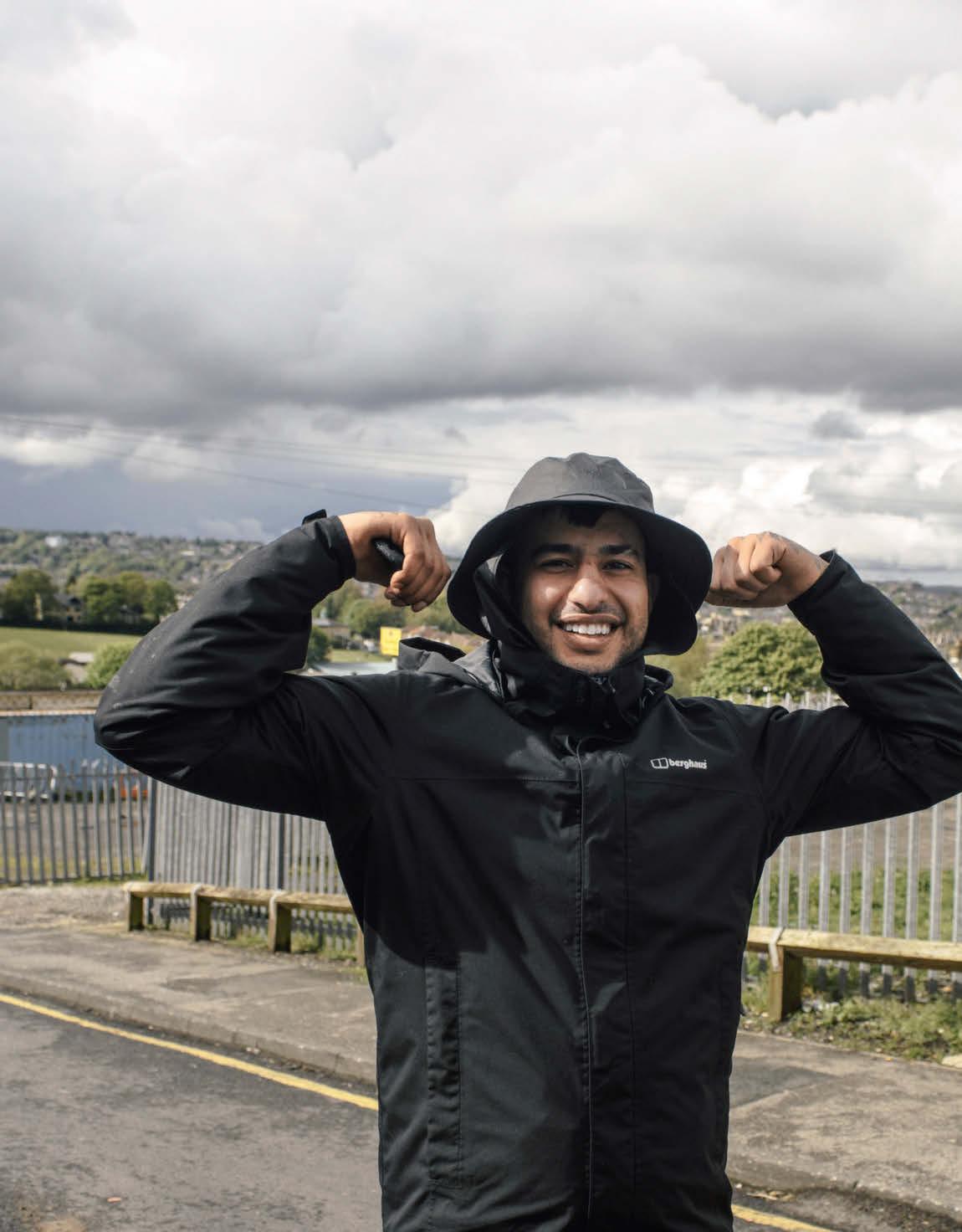
“I could always spit a rap just by listening to it a couple times. It’s a weird talent”
THE RED BULLETIN 57
S Dog
they’re zooming around sand dunes on quads and motorbikes, rapping about masks, money and making it. “That were a life changer, that were,” S Dog says. “Now, everywhere I go, everyone wants to have pictures with me ’n’ that. People pay me to cut ribbons outside shops ’n’ shit.”
Bradford’s artists have created their own musical ecosystem because they have to. A return train to London can cost upwards of £100, so it’s sometimes cheaper to fly to Spain from the nearest airport than to reach the UK’s cultural capital. The young musicians don’t have access to the industry in London, so they team up with each other, building a hyper-local scene that connects with the youth much more than a rapper from the South possibly could. That’s why BBCC continue to collaborate with artists in the area, turning them into local celebrities, too.
Becce J is a good example. The Preston-born but now Leeds-based singer is best known for her vocals on BBCC’s track Always Be My Baby Boy, from their album Disrespectful. BBCC’s manager reached out after she posted a cover of their track Don’t You
Worry About Me on TikTok. A few weeks later she was with them in the studio, and a few weeks after that she was on tour with the boys, singing to thousands of screaming fans.
“I don’t really see it as such a huge thing that I’ve done a track with BBCC,” Becce J says, sitting in a café in a local shopping centre. “Everyone gives each other a leg-up, and the boys helped me loads when they asked me to tour with them. Leeds Festival [last year] was the biggest crowd I’ve ever seen.”
Bad Boy Chiller Crew will not be playing Leeds Festival again any time soon. They turned up late for their slot last August, downed pints of beer and spirits on stage, overran their allotted time, and then got into a fight with the production crew when the plug was pulled. A few hours later, two of BBCC allegedly had to be bailed at the local police station.
“Yeah, we’re on our last warning across the board,” says GK over the phone. “It’s a job now and it’s time to act a bit responsible. We’re gonna be on our best behaviours for this tour.” BBCC didn’t set out to be role models, but they’ve surrendered to the fact that they are. “The kids do look up to us, yeah,” GK says. “But you know, we got signed as Bad Boy Chiller Crew, not Good Boy Chiller Crew.”
They’re in a pickle, basically. BBCC became famous for reflecting life in Bradford, but now that they’re part of the music-industry machine, the very traits that made them popular are holding them back. It’s a balancing act, and the strain in GK’s voice is obvious. “I lost my gold star on Snapchat last year
In the moment: (above) a BBCC fan FaceTimes a relative during the O2 show – a love of bassline spans generations in Yorkshire; (opposite, from top) “Everyone [in the scene] gives each other a leg-up,” says singer Becce J; producer Sluggy Beats, whose In The House collaboration with MC Marky B hit a million streams on YouTube in June

Bassline
“It’s not a front. This is who we are, mush”
58 THE RED BULLETIN
GK, Bad Boy Chiller Crew


for drug references on tour,” he says. “I’ve only just got it back. You can’t put people in the limelight and then, when it’s time to behave, make us stop it. This is who we are. We’re standing on hot rocks everywhere we go. It’s hard to be bad nowadays.”
However, GK understands that being part of Bad Boy Chiller Crew is a once-in-a-lifetime opportunity so it’s probably best to behave. “Nobody from our world gets the chance to do the shit we do,” he says. “If it weren’t for Bad Boy Chiller Crew, I’d still be circling the estates of Bradford and Leeds and blasting out bassline tunes in my ice-cream van.”
Many of Bradford’s bassline artists are entrepreneurs at heart. Take Sluggy Beats. He meets us at Bradford Interchange railway station on a drizzly afternoon, looking studio-fresh in a black North Face cap and jacket. Sluggy Beats studied music production at Wakefield College, a 40-minute drive from Bradford, and started writing hip-hop tracks during lockdown. Even when not in a global pandemic, there’s not much to do in his hometown, so making music was a better alternative to hanging out in a field. His productions weren’t quite clicking, though. Then he began listening to BBCC. “I discovered all these MCs rapping over house and decided to combine the two genres and build my name off of that sound,” Sluggy Beats says. He uploaded some of his music to YouTube and got some traction, but realised he’d have to think outside the box if he wanted to make a career of it: “People buy the name rather than the music, so I started moving more like an artist than a producer.” He’d make a beat with, rather than for, an artist to make the process more collaborative.
Inspired by drill communities, Sluggy Beats created In The House, his own freestyle series on Spotify where a guest MC would rap over one of his tracks. So far, he’s worked with bassline royalty including Marky B, KAV, YA and Wilko, and has built a reputation as one of West Yorkshire’s most prominent producers. It’s now his full-time job, and he credits BBCC for paving the way: “You’ve got young people from the estate thinking, ‘If they can do it, why can’t I?’”

The Red Bulletin meets YA on the Buttershaw estate on the outskirts of Bradford, BD6. The MC is waiting on a dirt track behind some shops – he says he’s been banned from entering them – wearing a black hooded jacket and a huge necklace with a picture of his father, who recently passed away
At first glance, you wouldn’t know this estate is one of the worst-funded in the UK – the red-brick houses look well-kept and there’s greenery everywhere.

“Good things are coming to Bradford”
60 THE RED BULLETIN
YA
But there’s also an emptiness to the place, like it’s been forgotten. A pony grazing on the grass just adds to the sense of detachment.
YA grew up around here, although he’s lived all over Bradford. He began MCing at the age of eight, inspired by the sounds played at Niche in the early 2000s. “I wanted to be like them, innit,” he says.
“So I started freestyling, writing bars, then I put stuff on YouTube when I were 15. Got views ’n’ that, people listening. Then I stopped for a bit and started dropping tunes again two or three year ago.” YA stopped making music to help raise his daughter –and picked it up again for her, too: “Thought I better try and make something of it while I can, innit.”
Music helped keep YA out of trouble when growing up. “When I were 10, 11, I used to do crazy stuff on this estate,” he says. “There weren’t owt for us to do, no youth clubs, so what we meant to do?
Go smash shit up and get a chaser, innit.” A chaser, he explains, is when you throw stones at a car until the driver chases you down the street. This was the children’s entertainment.
“Everyone’s skint here,” YA continues. “You got kids round here – 13, 14 ’n’ that – breaking in

houses, nicking cars. That’s what happens on a daily, in every estate in Bradford. Their mum’s got no money, they’re on the dole, the family has £300 a month to live off, and there’s four of them.”

In 2025, Bradford will be the UK City of Culture, an accolade awarded by a government-administered bidding contest every four years. The result will be a major cultural and financial injection: more than 1,000 performances and events, 365 artist commissions, a series of major arts festivals, and national and international collaborations. But will the regeneration reach YA’s estate? “There’ll be investment in the centre of Bradford, but it’ll never affect people here,” he says. Instead, the youth here gain inspiration from other sources: “I get kids up to me saying, ‘You’re YA!’ That’s why I do it.”
YA is one of them, and his music reflects that. One of his most notable bangers is Bradford Army, the 2021 track he wrote with Marky B and KAV. The lyrics sum up Bradford’s culture and aspirations nicely: “I just wanna live life and party/They can’t do it like my Bradford army/Bro’s got the key for the E63/ I’mma bounce in the nightclub wearing Armani.”
Despite their struggles – or perhaps because of them – the energy coming out of this community is making waves around the world. “We’re starting to get noticed,” YA says. “Good things are coming to Bradford, innit.”
If bassline has emerged from a backdrop of harsh realities, it wouldn’t be the first music genre to do so – groundbreaking sounds including rap, disco and house were all born from a disenfranchised youth. And, much like those scenes, it provides something vital: liberation and a sense of belonging. While some parents might be concerned about its subject matter, bassline has an overwhelmingly positive impact in a city full of challenges for young people. “What were Snoop Dogg and 50 Cent rapping about back in the day?” asks GK. “Sex, drugs and rock ’n’ roll, innit. We’re just the Northern version. It’s not a front, it’s not a show. This is who we are, mush.”
It’s written all over the faces of the crowd at the O2 Academy Leeds as the boys from Bradford wrap up their set. A sea of bucket hats bounce along to fan favourite Don’t You Worry About Me, the crowd bellowing out Welsh’s opening verse: “Bradford boys still winning/Out here chilling/Come from crooks and villains.” A group of teenage girls jump as one, screaming along to the catchy chorus: “So don’t you worry ’bout me/I can carry myself home/ Cos I got it on my own.”
“Make some noise if you love BBCC!” GK shouts into the mic. The response is deafening. Somewhere in that crowd, there may be someone inspired enough to follow in their footsteps. As for Bad Boy Chiller Crew, regardless of how many records they sell or stadiums they fill, what matters is happening right here. They’re at home.
YouTube: @officialbbcc; @SluggyBeatsMedia; @s_dog___; @officialya7312. TikTok: @beccejoan
Bassline
Mane man: (above) a lone pony grazes on YA’s estate in BD6; (left) YA wears a necklace bearing a photograph to his late father
THE RED BULLETIN 61
A powerful place North Shore, O‘ahu, Hawaii
“This is a very special place for me,” says Zak Noyle, “because this wave basically launched my photographic career. There was an element of danger in snapping this surfer as I was taking photographs in the shallow reef. The reef is always a concern. You have to be prepared and pay attention when the swell rolls in. And don’t panic!”
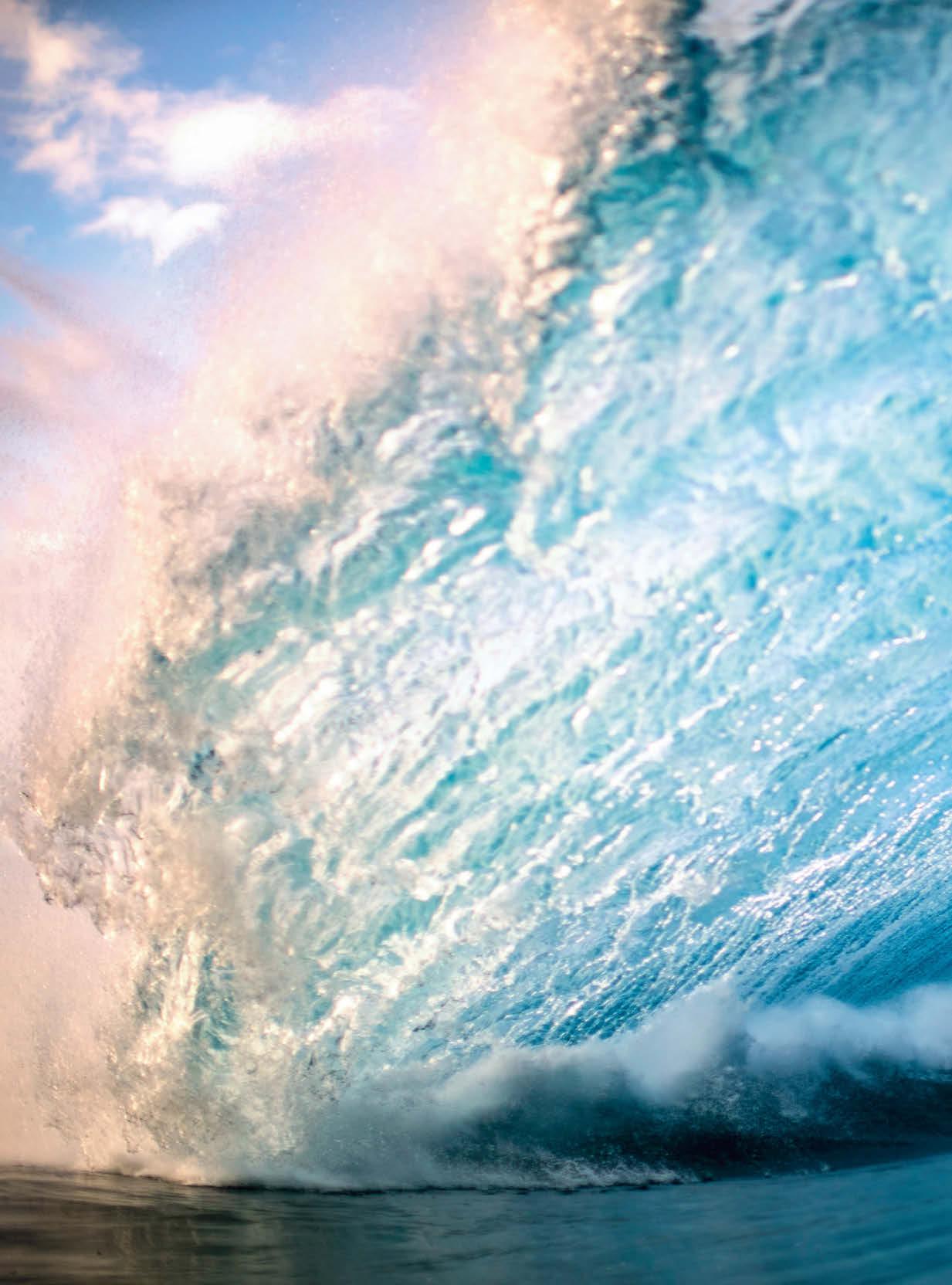
Waterworld
Hawaii-born Zak Noyle is a sports photographer who travels the world braving big waves in pursuit of surfing’s elite. But, says the 38-yearold, it’s the water that fascinates him most
Words NINA KALTENBÖCK
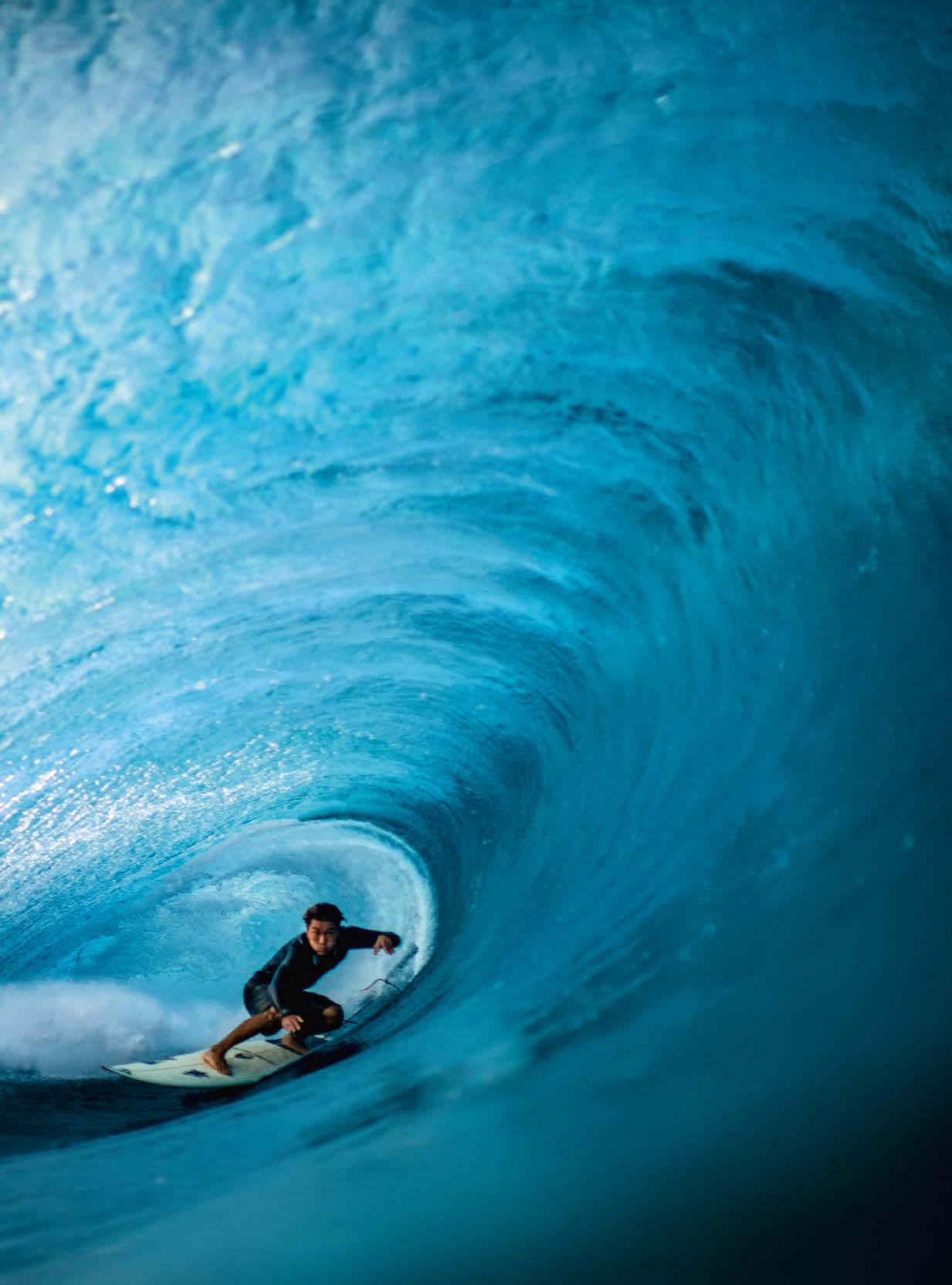
63
Zak Noyle
the photographer: ZAK NOYLE
Noyle describes himself as a “water photographer” who enjoys capturing waves more than surfers. “Anything that touches water is my speciality,” says the lensman, who confesses to being a mediocre surfer. “I love the ocean, but sharing it is what drives me.”
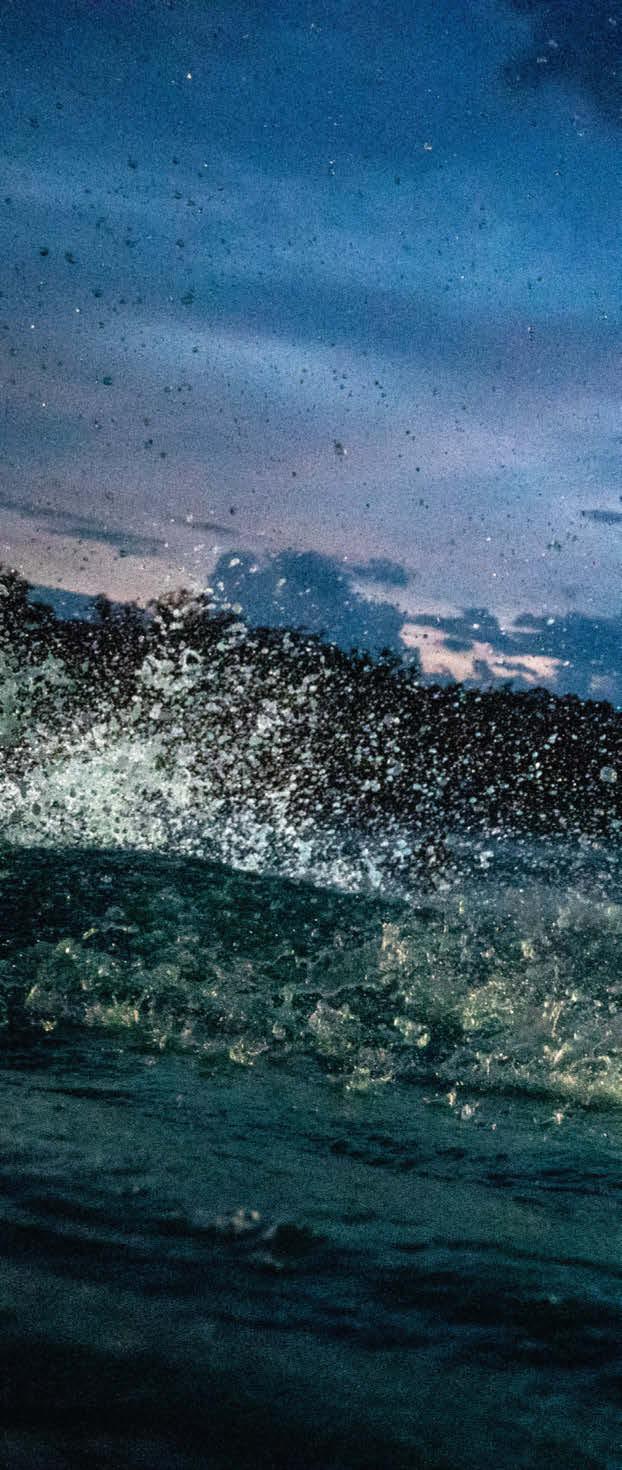

Most of us, he reasons, would never otherwise see the kind of moments he captures up close. But the Hawaiian is mindful of the risks that come with his chosen profession: “The ocean is deadly. Now factor in shallow reefs and massive waves. It’s very dangerous. But that’s what drives us to capture and ride these mountains of water. You can’t panic when you’re being toppled by a wave – it wastes energy. I need to remain calm and remember my preparation and training.”
Surfng may not run in Noyle’s family, but photography does: “My father is an advertising photographer who shot food, hotels and fashion, and he instilled the job in me when I was still in the cradle.” By turning his camera lens to the ocean, Noyle has united his passions. “The water has made my career and given me opportunities as well as a life. It’s something I deeply love and respect.”
zaknoyle.com; Instagram: @zaknoyle
64 THE RED BULLETIN
Night flight Austin, Texas, 2017
“Here, Ford Archbold is surfing beneath the stars in the Waco wave pool. I’ve shot at night many times before, usually in the ocean. It felt a bit safer and more predictable here; we could stand on the bottom and really get out positioning dialled. There were four of us – two people held the lights and tried not to get in the way of the surfer. It worked!”
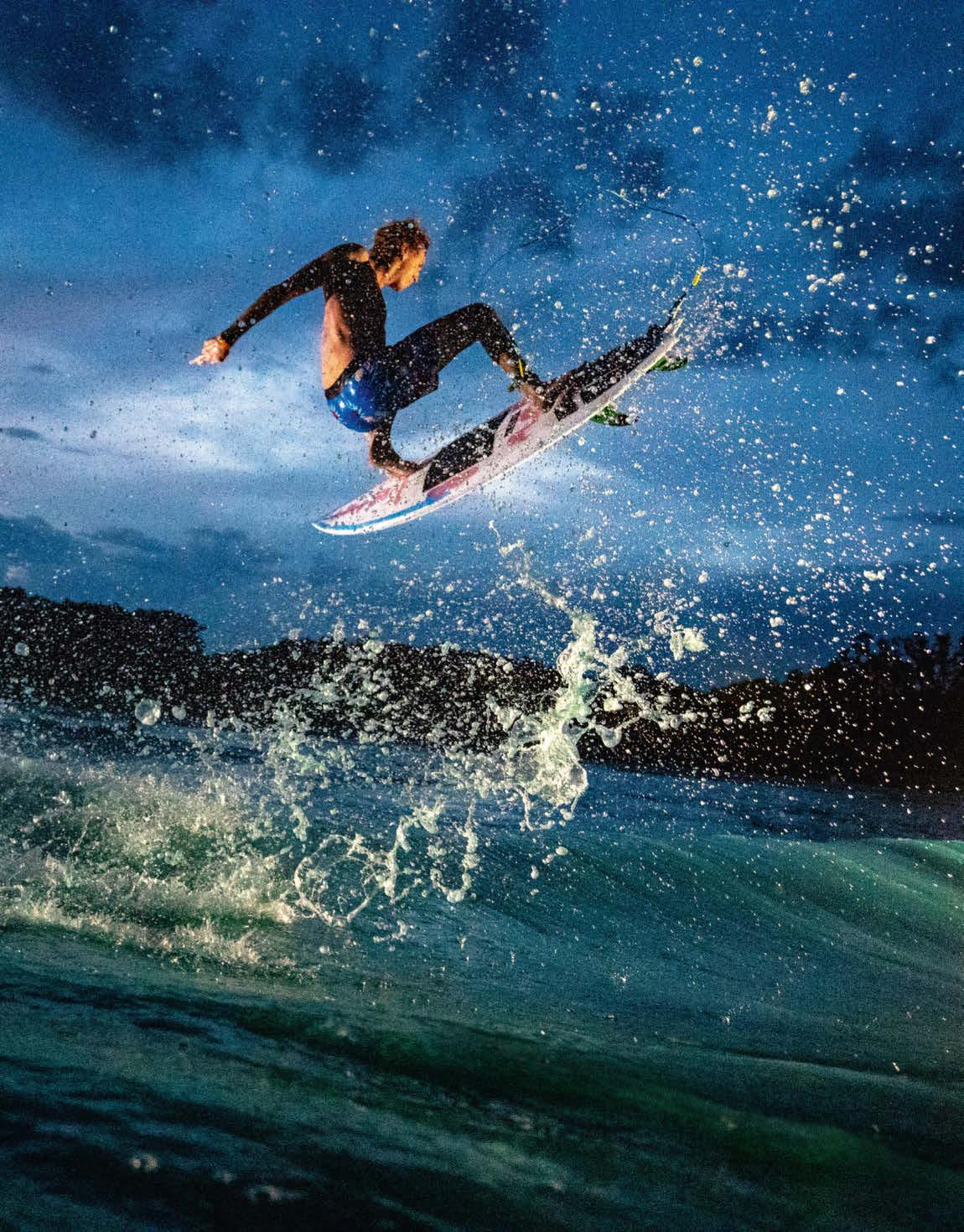
THE RED BULLETIN 65
Leading light
Costa Rica, 2017
“This shot is what happens when preparation meets opportunity. It all came together as Alex Knost noserode right in front of me with the sun behind him. Sometimes moments seem to slow down and stop, and this was one of those moments. It was perfect.”

Taking the tube
North Shore, O‘ahu, Hawaii, 2019
In competitive surfing, the wave to end all waves – the one you can roar through as if in a tunnel – is known as a pipeline. And this is the holy grail for Japanese surfer Taichi Wakita (pictured). “For him, ikigai – the Japanese philosophy of a meaningful life – is this special wave,” says Noyle.
 Zak Noyle
Zak Noyle
67

“Great pictures happen when preparation meets opportunity”
Zak Noyle
Unique take South Pacific, 2015
“[Fellow Hawaiian surfer] Ian Walsh and I were working on the Red Bull documentary Distance Between Dreams, an attempt to harness and ride the world’s largest ocean swells. There are no second chances. Unlike other sports, where you can attempt the same hill or rail repeatedly, you can’t do that in the ocean. Every single wave is different, which is what makes surf photography so exciting. You must be ready and on point. We found the best waves and the clearest water I’ve ever seen. It was a magical trip.”
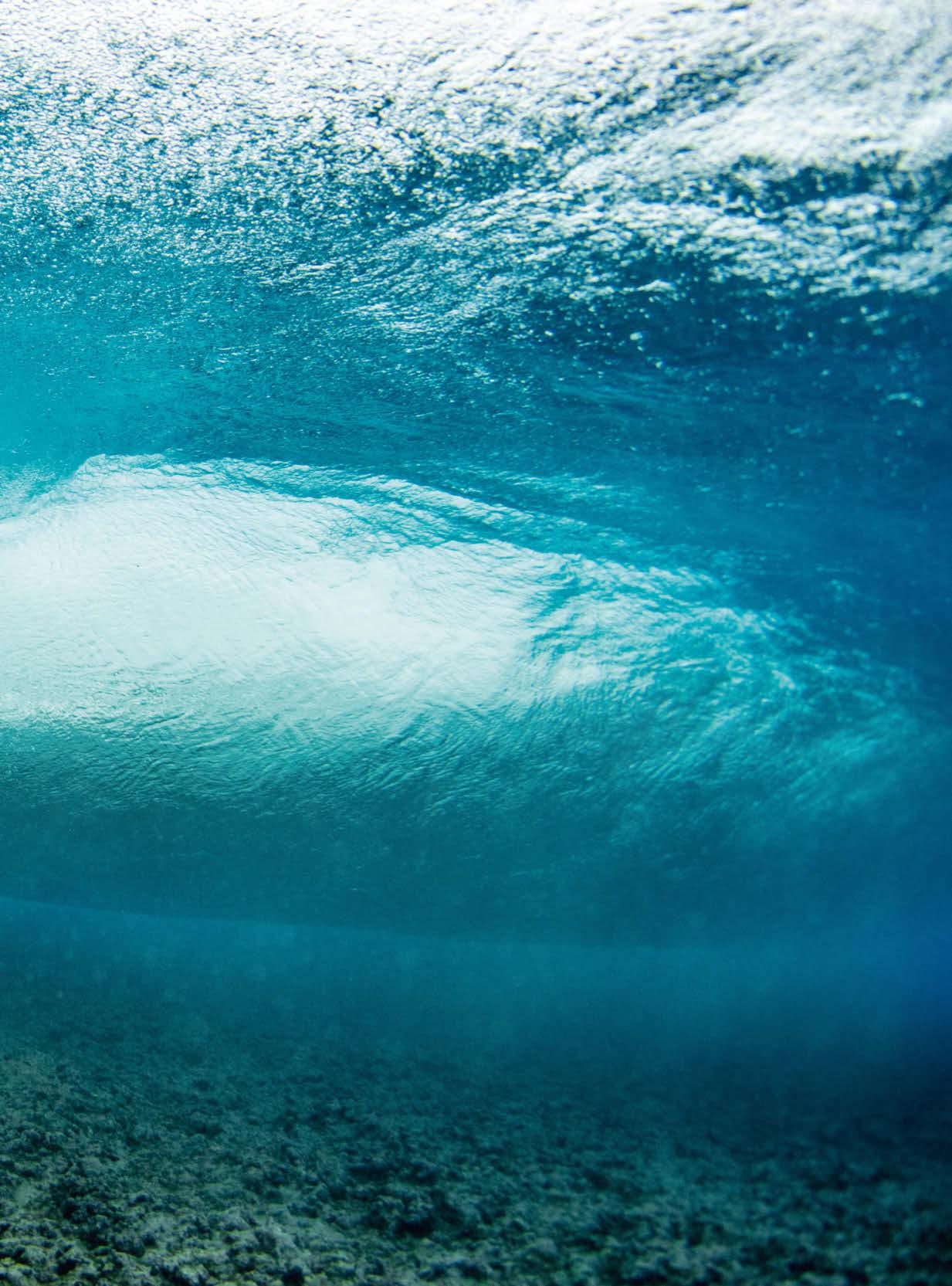
69
Zak Noyle

Young love Makapu‘u, Hawaii, 2016
“This is surfer Ezekiel Lau on O‘ahu’s East Shore. I grew up here, and this is where my father would take me to bodysurf. It’s where I fell in love with the ocean. I especially like the atmosphere when there’s a storm approaching. This photo takes me right back to that moment of total satisfaction.”

Great heights Mexico, 2009
“There was a reason for Jamie O’Brien leaping into the air. We’d spent a long summer chasing swells in Mexico for his documentary Who is JOB, and not every strike mission would net amazing results. It was always a gamble. But we got some epic waves to conclude the trip.”
70 THE RED BULLETIN
Swell times Undisclosed location, Japan, 2014
“Surfer Seth Moniz [pictured] and I had one impressive encounter after another here: crazy waves, the best food and the politest people ever. I’ve travelled to Japan quite often and it’s one of my favourite places in the world! And this is one of my favourite waves, [but I’m keeping it] secret.”

“Being there in the middle of extreme moments is what drives me on“

Zak Noyle
“I live by my father’s advice: lots of pictures, strict selection”
Pool party
Austin, Texas, 2017
“This is Noah Beschen giving it his all in the Waco wave pool. It’s an excellent training ground for surfers, and capturing the moment is much easier here than on the open sea as the waves always break in the same way.” It also acts as a training ground for Noyle, allowing him to experiment more with his equipment.

73
































































































































































VENTURE
Enhance, equip, and experience your best life
HANGING OUT
Bouldering in Ticino, Switzerland

75
STEFAN KUERZI SIMON SCHREYER
I’m hanging from a large boulder, looking for my next move. My fingers grip tightly onto a ledge only a few centimetres deep, which runs along the face of the granite, offering a possible path to the top. I lift my right foot and dig it into a small hold, enabling me to lift myself slightly further then pause again, feeling the warmth of the sun on my back. Finding a route is like solving a puzzle, and although I’ve been coming to the canton of Ticino in Switzerland for bouldering for more than a decade, this rocky landscape of gneiss and granite never fails to challenge me.
As a professional climber I’ve travelled a lot, and for me Ascona-Locarno is one of the world’s most beautiful and diverse areas for climbing and bouldering. With its endless mazes of boulders and a


horizon dominated by snow-capped 3,000m peaks, the location has become a magnet for climbers of all kinds, who, like me, come here in all seasons; it’s pretty warm even in the winter when the lowlands stay free of snow. But autumn is my favourite time of year to visit southern Switzerland, because of the intense colours of the surrounding forests.
Today, I’m bouldering in Brione in the Verzasca valley. I’ve brought my husband Ned and our young daughter, who’s dozing peacefully in the shade of the boulders as we climb. I’ve climbed some favourite problems here over the years, including the classics: There is No Spoon (graded 7B/V8), Real Pamplemousse (8A/V11) and Molonk (7C/V9). In a lot of the more popular areas, there are signs to the boulders, which is something unique
to this area. It makes the climbing much more accessible for people of all abilities. There’s also a lot to explore when you’re not climbing. We’re next to the cold blue-green waters of the Verzasca river, which attract swimmers and divers, and around us are fairy-tale villages made up of stone houses built into the steep slopes so that they almost become part of the natural landscape.
Nearby there are Roman-era stone bridges with their round arches, such as the Ponte dei Salti near Lavertezzo, which straddles emerald waters. And the dam in the Verzasca valley holds a special significance for me: the headto-head climbing competition Red Bull Dual Ascent is held on its 200m-high walls. I competed in 2022, alongside incredible fellow climbers including
VENTURE Travel
“My fingers grip tightly onto a ledge only a few centimetres deep, which runs along the face of the granite”
Shauna Coxsey, professional climber
76 THE RED BULLETIN
STEFAN KUERZI
VENTURE Travel

For anyone who loves the outdoors, Ticino offers a Mediterranean way of life in an alpine landscape, stretching from the main ridge down to Lake Maggiore, on the northern shores of which are the Italian-speaking towns of Ascona and Locarno with their renowned festivals. Today, a bus has transported us from Locarno to Brione in less than an hour, and from the bus stop it’s only a few minutes’ walk to the nearest rocks.
Yesterday, we rented stand-up paddleboards in Ascona-Locarno, wending our way through the deep-blue river delta. The view from the water is beautiful, with the palm trees and colourful houses of Muralto in Locarno along the shore, and the snow-capped Alps in the background.
 Sasha DiGiulian, Jacopo Larcher and Babsi Zangerl.
Hold tight: Shauna Coxsey boulders in the Verzasca valley; (opposite) the climber and her husband Ned take a hike with a view of Lake Maggiore; (opening page) tackling a rockface in Ticino
Sasha DiGiulian, Jacopo Larcher and Babsi Zangerl.
Hold tight: Shauna Coxsey boulders in the Verzasca valley; (opposite) the climber and her husband Ned take a hike with a view of Lake Maggiore; (opening page) tackling a rockface in Ticino
THE RED BULLETIN 77
Testing the waters: Coxsey goes stand-up paddleboarding on Lake Maggiore
A small, old train in Muralto takes you to the bottom of the ski lift in Orselina. Within just a few minutes you’re up a mountain, high above the lake, with a panoramic view. You can stay at Cardada (1,340m) or continue on the chairlift to Cimetta (1,670 m), the starting point for a number of well-signposted hikes and mountain bike trails.
At Cimetta, there’s a viewing platform where you can enjoy a 360° panorama; you can see from the lowest point in Switzerland (Lake Maggiore, 193m above sea level) up to the highest (the Dufourspitze in the Monte Rosa massif, 4,634m). This gives me a reset after a full-on day of bouldering.

But, of course, for me the real allure is the chance to put my skills to the test. I finally reach the top of the large granite
Bern Switzerland
TICINO
Locarno Ascona
Getting there
The quickest route to Ticino
From the UK, the fastest way to get to Ticino is by flying to Milan, then travelling to Locarno by train (this second part of the journey takes around two hours). SBB trains (those operated by the Swiss national rail company) also go direct from Zurich, Basel or Lucerne to Locarno. For more information, go to ascona-locarno.com
Good to know What you need for bouldering
The basics: climbing shoes, chalk bag, comfy clothing, a brush to clean the grips, and a crash pad or two. “Seek some guidance the first time you try bouldering,” suggests Coxsey. “It’s important you know how to get down off the boulder as well as knowing how to get up!” Guide books by Claudio Cameroni, the father of Ticino bouldering ace Giuliano Cameroni, contain descriptions of all the major routes in the area.
formation and rest on the warm, flat rock in the sun as my tired fingers buzz. My daughter is awake now, so we all head back down the valley towards Locarno, stopping at the restaurant Casa Colmanicchio for a selection of local cheeses and the traditional rösti. They also serve mandarinade – like lemonade, but made from the mandarins that grow here.
I’m already thinking about tomorrow and finding fresh problems to tackle. This is my idea of la dolce vita – being up close to the rock, surrounded by pristine forests, being challenged by nature. I can’t imagine not coming back.
Shauna Coxsey, 30, is a two-time World Cup bouldering champion from Cheshire; Instagram: @shaunacoxsey; redbull.com

VENTURE Travel
Time to chill: relaxing with Ned, their baby daughter and an ice cream
Balanced view: Coxsey enjoys the vista from the platform at Cimetta
78 THE RED BULLETIN STEFAN KUERZI

Lucy Cork’s first job was riding a bicycle into some bins. After an intensive two-and-a-half-year process to join the British Stunt Register, where she had to train three times a day and specialise in disciplines as varied as scuba diving and trampolining, it was quite the crash back to reality. “You have to start somewhere though, right?” she laughs.
Cork’s big breakthrough came when she was cast as Rebecca Ferguson’s double in Mission: Impossible – Rogue Nation (2015) The role saw her thrown in at the deep end, literally, as she was dragged around underwater by a wire while saving Tom Cruise’s character from certain death.
“That’s probably one of the scariest things I’ve ever done underwater,” Cork says. “The actress [I was doubling for] was basically in underwear. They made me special contact lenses, but underwater you only see a blur. On the wire, I was facing horizontally, so water went up my nose. It was just horrendous, being thrown around underwater and not being released [from the wire] until they yelled ‘cut’.”
The 31-year-old has since jumped from moving cars (for Rachel Weisz in Black Widow) and fought Dwayne ‘The Rock’ Johnson (as Vanessa Kirby’s stunt double in Fast & Furious: Hobbs and Shaw). Most recently, she reprised her Mission: Impossible role in the franchise’s latest outing.
The physical nature of the job demands a lot of work both on- and off-camera, so Cork has a balanced – if intensive – training structure in place. Honed over years of surviving extreme ordeals, these lessons have everyday benefits.
Loosen up
Jumping from a moving car over and over again in the streets of London in the early hours was standard when she worked on Black Widow. Cork uses caffeine to keep her alert late into a shooting schedule
Fights, stamina, action
Big-screen stunt performer Lucy Cork shares tips on how to build a bulletproof body, even if you’re not in the firing line


and knows the importance of prep before physical activity. To prevent injuries, she never goes on set with cold muscles: “I do dynamic warm-ups focusing on shoulders, neck and hips, then run through [the stunt] slowly and build it up.”
Find the one
When Cork gets a new role, she’ll seek out expert tuition for that particular skill. “In Hobbs and Shaw, there was a lot of parkour, so I did a lot of training for specific moves.” Whether you’re starting something from scratch or looking to take your chosen discipline to the next level, Cork recommends one-on-one lessons rather than joining a group. “You learn so much more. They won’t be looking at a whole group, just at you, and if you have any questions you’ll get an answer straight away. And it’s a lot harder [physically] – there’s no hiding.”
Pace yourself
Even when not preparing for a role, Cork will train twice a day to keep her whole body strong and ready for anything the job entails. It’s not all about going hell for leather, though: “You have to be clever with training. If I have a big fight or a specific stunt coming up, I’ll go easier. It’s not about torturing myself every session, especially when I have months of physical action ahead.” She also does
daily cardio sessions to boost overall endurance, helping her “perform all day with 100-percent effort and commitment”.
Hold steady
Filming a series such as The Witcher can feel like taking part in a hardcore HIIT workout for weeks at a time. “Henry Cavill and I rehearsed this [particular] fight a lot – it was precise with really intricate moves. If the timing was off, the energy wasn’t intense enough or something went wrong, we’d have to redo the whole thing. There were many long takes; it was exhausting.” Cork now uses ice baths and sauna sessions for recovery, and intersperses her schedule with less-intense forms of exercise to help maintain her martial-arts skills without burning out. “I need balance, which is where yoga and Pilates come in,” she says. Instagram: @lucycork
VENTURE Fitness
“Being thrown around underwater was horrendous”
Lucy Cork, stunt performer
TRAIN
80 THE RED BULLETIN
JOEL HICKS, MICHAEL CARLO
CHARLIE ALLENBY
SUBSCRIBE NOW 10 issues
The Red Bulletin


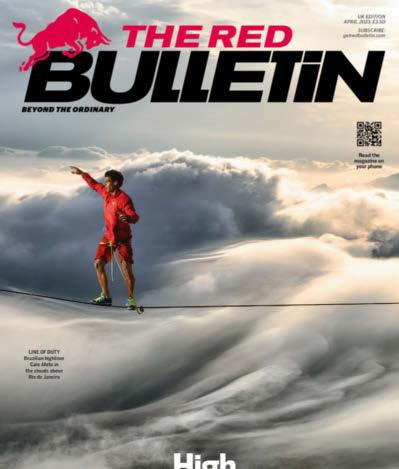






The next issue is out on Tuesday 10 October with London Evening Standard. Also available across the UK at airports, universities, and selected supermarkets and retail stores. Read more at theredbulletin.com


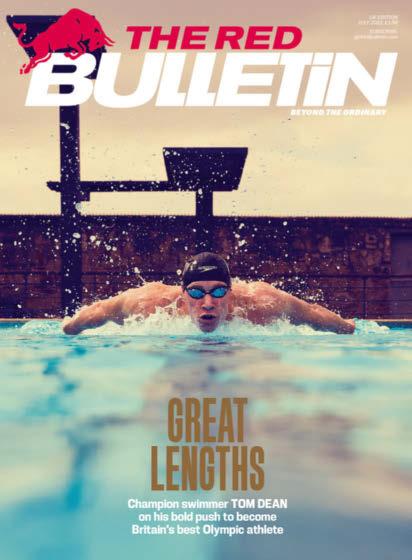

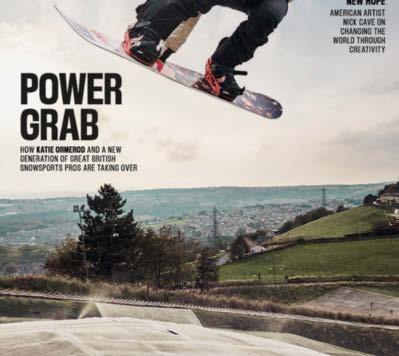
ONLY
getredbulletin.com
£20
REFRESH Liquid assets
Because when dehydration catches up with you, a water bottle isn’t just a water bottle…
VENTURE Equipment
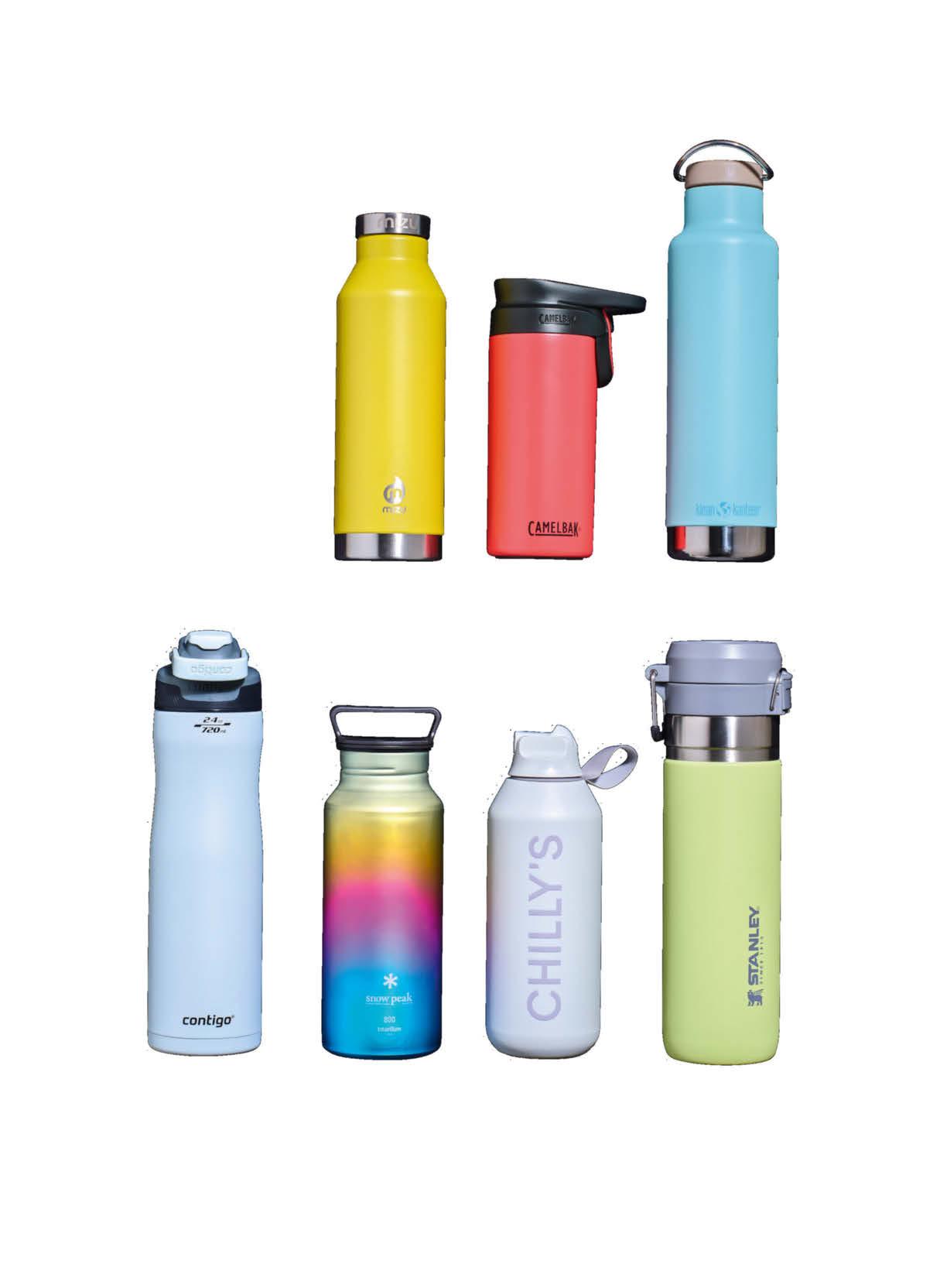 Top row, from left: MIZU V6 Bottle, mizulife.eu; CAMELBAK Forge Flow Vacuum Insulated Stainless Steel Travel Mug 350ml, camelbak.co.uk; KLEAN KANTEEN Insulated Classic 20oz, kleankanteen.co.uk
Bottom row: CONTIGO Chill Autoseal Vacuum Insulated Water Bottle 720ml, mycontigo.com; SNOW PEAK Titanium Aurora Bottle 800, uk.snowpeak.com; CHILLY’S Series 2 Flip, chillys.com; STANLEY Go Quick Flip Water Bottle 0.70L, uk.stanley1913.com
Top row, from left: MIZU V6 Bottle, mizulife.eu; CAMELBAK Forge Flow Vacuum Insulated Stainless Steel Travel Mug 350ml, camelbak.co.uk; KLEAN KANTEEN Insulated Classic 20oz, kleankanteen.co.uk
Bottom row: CONTIGO Chill Autoseal Vacuum Insulated Water Bottle 720ml, mycontigo.com; SNOW PEAK Titanium Aurora Bottle 800, uk.snowpeak.com; CHILLY’S Series 2 Flip, chillys.com; STANLEY Go Quick Flip Water Bottle 0.70L, uk.stanley1913.com
82 THE RED BULLETIN TIM KENT
VENTURE Equipment
 Top row: HYDRAPAK Recon 25oz/750ml, hydrapak.com; LIFESTRAW LifeStraw Go Series 1L BPA Free Water Filter Bottle, eu.lifestraw.com; BLACK+BLUM Glass Water Bottle, black-blum.com; HYDRO FLASK 21oz Standard Mouth with Flex Straw Cap, hydroflask.com
Bottom row: AIR UP Ocean Blue Bottle, uk.air-up.com; DOMETIC Thermo Bottle 66, dometic.com; ZOKU 18oz Stainless Steel Flip Top Sports Bottle, zokuhome.com; YETI Rambler 18oz (532ml) Bottle, uk.yeti.com
Top row: HYDRAPAK Recon 25oz/750ml, hydrapak.com; LIFESTRAW LifeStraw Go Series 1L BPA Free Water Filter Bottle, eu.lifestraw.com; BLACK+BLUM Glass Water Bottle, black-blum.com; HYDRO FLASK 21oz Standard Mouth with Flex Straw Cap, hydroflask.com
Bottom row: AIR UP Ocean Blue Bottle, uk.air-up.com; DOMETIC Thermo Bottle 66, dometic.com; ZOKU 18oz Stainless Steel Flip Top Sports Bottle, zokuhome.com; YETI Rambler 18oz (532ml) Bottle, uk.yeti.com
THE RED BULLETIN 83
CHOOSE
School of thought
Retrain your brain, banish harmful negative thinking and take back control of your choices

How many thoughts does each of us have in a day? According to research published in the scientific journal Nature Communications in 2020, it’s around 6,200. What’s more, a paper presented in 2005 by the US’s National Science Foundation suggested that 95 per cent of these are thoughts from the day before, and four out of five are negative.
Instead of living with such pessimistic perceptions, what if we could train our minds to think more constructively?
The Choice Point, a new book by cognitive behavioural therapist Joanna Grover and psychologist Jonathan Rhodes, aims to help us do just that.
As the title suggests, it’s all to do with choices. Your brain processes thousands per day, but, says Rhodes, “Few really define who you are in a single moment.” This is where the choice point comes in: “It’s a defining moment when a potential behaviour conflicts
with a core value. We estimate you have about 80 a day – for example, to eat the healthy option or not. In this moment, you have a decision that can lead you closer to your dream goal or further from it. All those small choices add up to who you are. If we can control those, that’s a huge shift in the way we feel and think.”
The duo’s technique, Functional Imagery Training (FIT), involves a combination of mental imagery and ‘motivational interviewing’ – a counselling method that promotes behavioural change. Training yourself to use your imagination in this way, says Rhodes, can help you control negative thoughts and think, “How could I approach this differently, and what would that look like?”
While Rhodes’s clients tend to be high-flying CEOs and elite athletes, these techniques could be just as useful to the rest of us…
Determine your values
First, decide what’s important to you. Rhodes suggests determining five core values. “They could be the things you feel guilty about,” he explains, highlighting that clients sometimes cite health or family as values but then admit they rarely exercise or spend time with their family. “Start with behaviours that cause conflict, then reverseengineer and think about what values they link to.”

Break it down
These techniques work best with specific goals, but you’ll need to break them down into steps. Maybe there’s an exam looming and you’re worried you will fail. You could break it down like this: if you did more prep, you’d have more knowledge and therefore feel more confident. “With imagery in mind, you start with a big goal, but it’s a timeline and you work along it with what you can control.”
Come to your senses
FIT is about more than just visualisation. “We train you to use the five senses, plus motion and emotion. If your goal is to write a book, it’s thinking about things like: can you feel the book? Does it have that newbook smell? Maybe you’re talking to people about how your book has changed their life – that’s emotion-based.”
Right on cue
It’s helpful to have a cue to activate your imagery. “My cue is when I wake up and my feet touch the floor, I plan my day. For the high divers I work with, their cue is often clicking their fingers before they dive.” This prompts them to imagine their dive before they do it. “People use it in different ways. When I use imagery, it’s quite slow, but for some it’s quick: ‘What can I do in the next 10 seconds?’”
Face up to failure
“There’s an opportunity to fail with every goal, which brings anxiety, stress and sometimes fear and avoidance,” explains Rhodes. Rather than swerve the topic, he asks clients what it would look like if they did fail, believing it’s important to “go to that negative space” to put fears into perspective and overcome irrational thoughts. “We have conversations about how you change. It’s called ‘mental contrasting’ when you contrast between where you want to be and where you are, and what’s holding you back.” The Choice Point is out now, published by Little Brown
VENTURE How To
“All your small choices add up to who you are”
Jonathan Rhodes, psychologist
84 THE RED BULLETIN ALAMY, HAROLD F ESTIME ISABELLE ARON
THINK FAST
Despite its 125-year heritage, Ribble’s future-focused approach shows it’s just getting started
Cycling brands have a habit of making bold claims: the oldest, the fastest, the lightest. It was in this environment that, in 2017, Andy Smallwood became CEO of Ribble.
Founded in England’s Northwest in 1897, the brand certainly ticked the age box. But Smallwood wasn’t interested in dining out on its history. “The heritage is nice to have,” he says, “but for us it’s about looking forwards.”
Smallwood assembled a core team, including ex-WorldTour proturned-head of design Jamie Burrows,
and set about reinventing Ribble from the ground up. The focus would be on original, innovative designs and becoming the best British manufacturer on the market – not just another ‘me too’ brand that followed the crowd.
It wasn’t going to do it subtly, either. Its renaissance started in 2018 with 23 new models across a range of categories and disciplines and included the Ribble SL e – a 10.5kg e-road bike that was the world’s lightest, and which looked and rode like a non-assisted machine.
“The competition had big batteries bolted on them and weighed up to 17kg,” explains Smallwood. “That’s perfect when you’ve got assistance, but in a group ride the majority of time is going to be spent above the cut-off point of 15.6mph. You want the bike to feel like a conventional road bike.”
New Ribble established, the focus switched to going fast. Enter the Ultra SL R. While the rest of the industry was creating identikit aerodynamically optimised road bikes with wind-tunnelbacked numbers, Ribble again took
a different approach. “From day one, we looked at it on a holistic basis – the bike and rider working in harmony,” Smallwood says.
This approach saw Ribble rethink the whole bike, including the handlebars; designed to create turbulence, they minimise drag created by the rider in the process. It claims that the Ultra SL R is the world’s fastest aero bike, and these aren’t unsubstantiated boasts –Ribble is so confident in its findings that it released a white paper detailing the data.
Market disrupted, like the SL e, Smallwood is keen that these aero insights aren’t limited to Ribble’s top-of-the-range models. “We’ve invested in that technology and that design, so it’s only right that it trickles down through the range,” he says. “The future is definitely looking faster.”
For more information, go to: ribblecycles.com
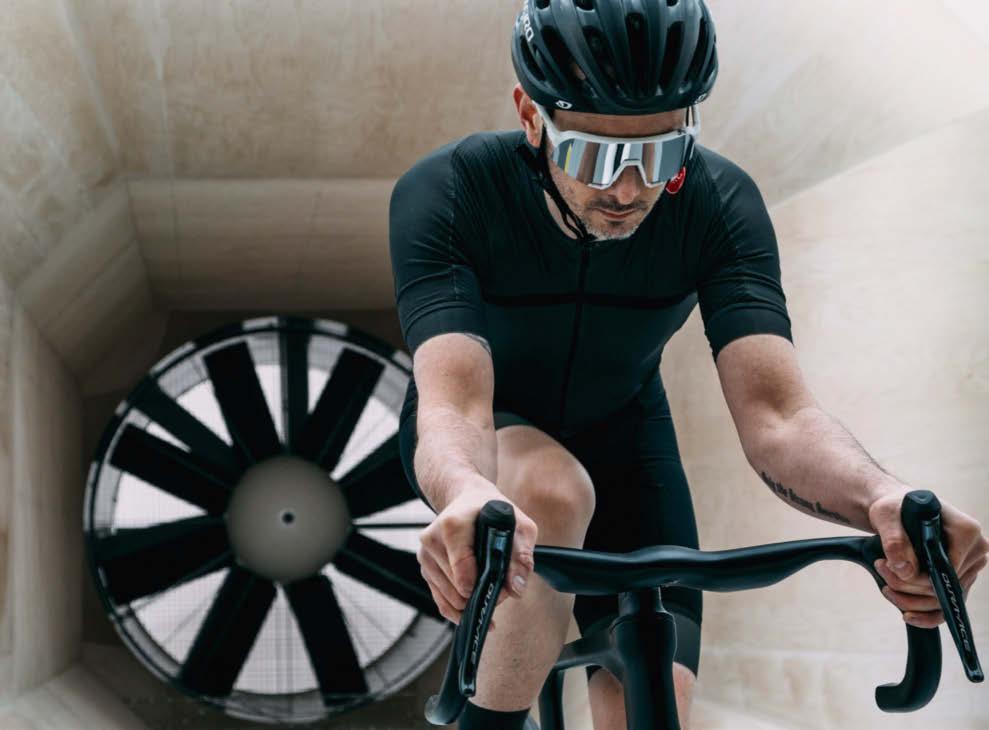
PROMOTION
RIBBLE
Tunnel vision: the Ultra SL R –designed by Ribble to be the world’s fastest aero bike
VENTURE Gaming
When it comes to racing simulation video games, the Gran Turismo series (GT) reigns supreme. The iconic racer first revved onto the scene in 1997, offering OG PlayStation owners an unparalleled immersive driving experience. Having sold more than 90 million copies worldwide, GT – now in its seventh iteration –is much-loved by gamers and car enthusiasts alike.
For Jann Mardenborough, though, the game has even greater significance: it changed the course of his life. The Darlington-born, Cardiff-raised gamer had already dedicated more than 10,000 hours to GT when, at the age of 19, his skills opened a door to his dream career. Mardenborough, who had no prior real-life racing experience, entered the 2011 edition of GT Academy – a competition co-funded by Sony and Nissan that rewarded the best GT gamer with a professional racing contract.
“I was very lucky – right place, right time,” he says. “I was sure I wanted to be a race driver. When the opportunity presented itself, I was all in.”

Putting into practise all the lessons he’d learnt in the game, Mardenborough beat 90,000 other entrants first in the virtual world and then on a real-life racetrack, earning himself a funded shot at the big time. Now 32, he has stood atop multiple podiums in series including the Formula 3 European Championship, GP3 and GP2, and even took third place at the legendary 24 Hours of Le Mans in 2013. Today, he competes in the Japan-based Super Taikyu Series.
Now, Mardenborough’s amazing progression from gamer to racer is the inspiration for a Gran Turismo film. The movie provides a fuel-injected reminder of how gains through gaming – boosting abilities like mental fortitude, adaptability and technical insight – can propel you to success IRL.
RACE
Sim it to win it
Jann Mardenborough’s story proves it’s possible to progress from pixels to top of the real-world podium
Enter the zone
For Mardenborough, having an edge on the racetrack goes beyond raw skill: “The most important part is the mental ability and the zone mindset.” He believes the composure honed in GT’s immersive gameplay, where a distraction could be something as minor as someone barging into your bedroom, has helped him learn how to quickly regain focus and control on the track, even if a hazard such as a near-miss disrupts his flow.
Conquer wet realms
Weather can be a formidable foe, altering track conditions and demanding quick adjustments. GT nurtured Mardenborough’s keen sense of weather reading, preparing
him for unpredictable real-life races. “Wet to dry, the lap time is around 12 to 15 seconds slower,” he says. “If there’s a lot of water, you must raise the ride height of the car by a couple millimetres to add more downforce. Otherwise, the car turns into a boat.” Mastering the rain-soaked
racetrack during the GT Academy, Mardenborough’s minor adjustments allowed him to glide through curves while rivals struggled for grip.
Go your own way
The racing line is the painter’s brushstroke on the canvas of the track. “In GT, they have the generic racing line and the recommended gear, but it’s not always right. With racing, especially when it’s wet, you have to make sure you’re not thinking about the status quo. Knowing your racing line just comes from completing continuous laps.” This attitude meant that when he stumbled upon an unconventional line by chance while racing IRL on Japan’s Fuji Speedway track, he went with it. “There’s a piece of concrete beyond the white line of the circuit that’s very grippy. I was entering Turn One at 160mph [260kph] and when I turned the wheel the front left wheel ripped on this piece of unused concrete and hooked me round the corner. The line was two times faster than my teammates and I was top of the time sheets.”
Optimise control
GT’s realism also made it a training ground for mechanical symphony as Mardenborough’s knowledge from the game gave him an advantage in car set-ups. During his debut in a powerful Nissan GT-R during GT Academy, subconscious adjustments mirrored those he’d practised virtually. “GT teaches you how to set up a car in terms of weight, spring rates and even anti-roll bar settings,” he says. “You learn in a controlled environment.” He adds that a direct drive wheel – a sim steering wheel mounted directly to a motor – can enhance the realism of playing GT due to an increased level of feedback such as torque, and help improve your real-life driving skills.
Gran Turismo: Based on a True Story is at cinemas nationwide; granturismo.movie

“The most important part is the mental ability”
Jann Mardenborough, racing driver
86 THE RED BULLETIN GORDON TIMPEN/SONY BABAJIDE OSIKOYA
Rest assured
A good sleep mask can vastly improve a night’s slumber, but this one can restore you even when you’re awake...
Therabody’s SmartGoggles are deceptive. First, there’s the name, which hints at VR. Rather than enhance your vision, though, these ‘goggles’ deprive you of it and add their own sensory stimuli.
Inside this comfortable eye mask is tech for creating heat and vibration patterns. There are three presets, each lasting 15 minutes. Hit ‘SmartRelax’ and it warms up to 37°C (just above skin temperature) as a heart-rate sensor scans blood vessels beneath your eyelids,


matching your pulse before gradually lowering the rhythm, causing your heartbeat to slow.
‘Focus’ turns up the heat to 40°C, with a steady pulse to relax the mind and ease tension around the brows, and ‘Sleep’ massages the temples with no heat (this is most conducive to rest).
So, it’s a portable calming machine, reducing pain and stress and helping you sleep. Yes, even in economy class. therabody.com
VENTURE Fitness Gear RECOVER
An accompanying app plays binaural beats (two tones at differing frequencies) to trigger a parasympathetic response in the brain, similar to meditation
THE RED BULLETIN 87 TOM GUISE
Trail
Take on any terrain with this adaptable 30-litre rucksack. Pole holders and an attachment for an ice axe ensure vital gear is kept close at hand, and adjustable straps enable you to perfectly tailor weight distribution.

DEUTER Trail 30, deutergb.co.uk
VENTURE Equipment
MOVE Bags for life
Hold all your adventure needs in these clever carriers
Commute
Turn heads on public transport with this limitededition release. An internal 15in sleeve protects your laptop, while the nature-inspired design by Swedish graphic artist Mander ensures you stand out from the crowd.
FJÄLLRÄVEN Kånken Art Plus, fjallraven.com




Camp
Keep your kit moisture-free with this durable dry bag from watersports specialist Red, which includes removable padded airflow straps to ensure your back doesn’t get damp either. RED Waterproof Roll Top Dry Bag Backpack, red-equipment.co.uk


Bike
Don’t let limited supplies cut your off-road exploits short. This backpack from CamelBak features a three-litre hydration system as well as room for snacks and extra gear, and even a bike-tool organiser roll.

CAMELBAK HAWG Pro 20, camelback.co.uk

Run
Looking for a way to carry supplies on longer runs? Meet the Norvan 7. This breathable vest packs two 500ml flasks and has stretchy pockets for layers and nutrition supplies. You won’t want to leave home without it.
ARC’TERYX Norvan 7 Vest, arcteryx.com

88 THE RED BULLETIN TIM KENT CHARLIE ALLENBY
VENTURE Equipment
Ski
It might sound like hyperbole, but this backpack could literally save your life. Its integrated Alpride E2 Airbag system can be deployed in the event of an avalanche, leaving you free to explore the backcountry in safety and confidence.
OSPREY Soelden Pro Avy 32, ospreyeurope.com

THE RED BULLETIN 89
TAKING THE PLUNGE
Canyoning in the Golan Heights, Israel

“Normally with my clients, I fix a separate safety line just in case. But since you’re a seasoned climber, you’re comfortable without one, right?” Standing at the cliff’s edge, the roaring water reverberates off the black canyon walls. My guide, Stav Kama, threads the rope through the figure-eight rappelling device attached to my harness. I take a deep breath to calm my nerves and draw upon the confidence that comes from more than three decades of climbing experience as a line of eager canyoneers from other groups forms behind me, waiting their turn to descend the 25m waterfall into the hidden, icy-cold pool below.
Our location for the day, Zavitan Canyon, lies within the Yehudiya Nature Reserve in Golan Heights, Israel. Although historically significant and
politically contentious, the country’s northeastern region – which borders Lebanon, Syria and Jordan – boasts an abundance of natural beauty, preserved by the Israelis through a growing network of nature reserves and national parks. “This is one of the last truly wild places in Israel,” Kama tells me, “and it’s where I’m most happy.”
A deep and imposing canyon, this mesmerising natural wonder seems worlds away from the throngs of pilgrims in their airconditioned coaches clogging the shores of the Sea of Galilee less than 20km away to the south. Divided into three distinct sections – the upper, lower and middle –Zavitan offers a hiking, climbing, abseiling and swimming experience like no other. Having previously rappelled down waterfalls and leapt into pools across Europe, North and South America, and also to the south in
Jordan, I never imagined doing so in Israel. Until now.
We started our journey early in the morning to be the first at the park gates when they opened at 7am. Equipped with helmets, harnesses, ropes and climbing hardware, our dry bags laden with gear, we set off on the short 30-minute trek to the canyon’s edge. Along the way, the growing heat revealed a sprawling savannah-like landscape, offering views of the great rift of the Jordan River Valley and the Lebanese hills in the distance.
Reaching the start of the Black Gorge Trail, we geared up and descended into the canyon. A jewel in the crown of the canyon’s middle section, this 6km trail features a trio of magnificent waterfall rappels. Each varies in height –ranging from approximately 6m to 25m – and requires a distinct rappel set-up.
Navigating through dense bamboo, vibrant pink oleander bushes and lush streamside vegetation that clambers over boulders, we approached the first of the waterfalls. This being just less than 10m tall, we decided to forgo the rappel and instead opted to scramble along the cliff edge to reach a spot low enough to fling ourselves into the frigid pool below and swim towards the first big abseil of the day.
My harness secured and my heels hanging over the edge into the eight-storey void below, I remember the teachings of medieval Jewish philosopher Abraham Ibn Ezra, who wrote, “The past no longer exists; the future is not yet a reality; the present is but a fleeting moment. Why then should one worry?” Embracing the biblical
Taking hold: Jurries scrambles along the limestone walls of the canyon, the unforgiving rock contrasting with the lush vegetation surrounding it
JAKE BAGGALEY
“My harness secured and my heels hanging over the edge into the eight-storey void, I drop into the darkness below”
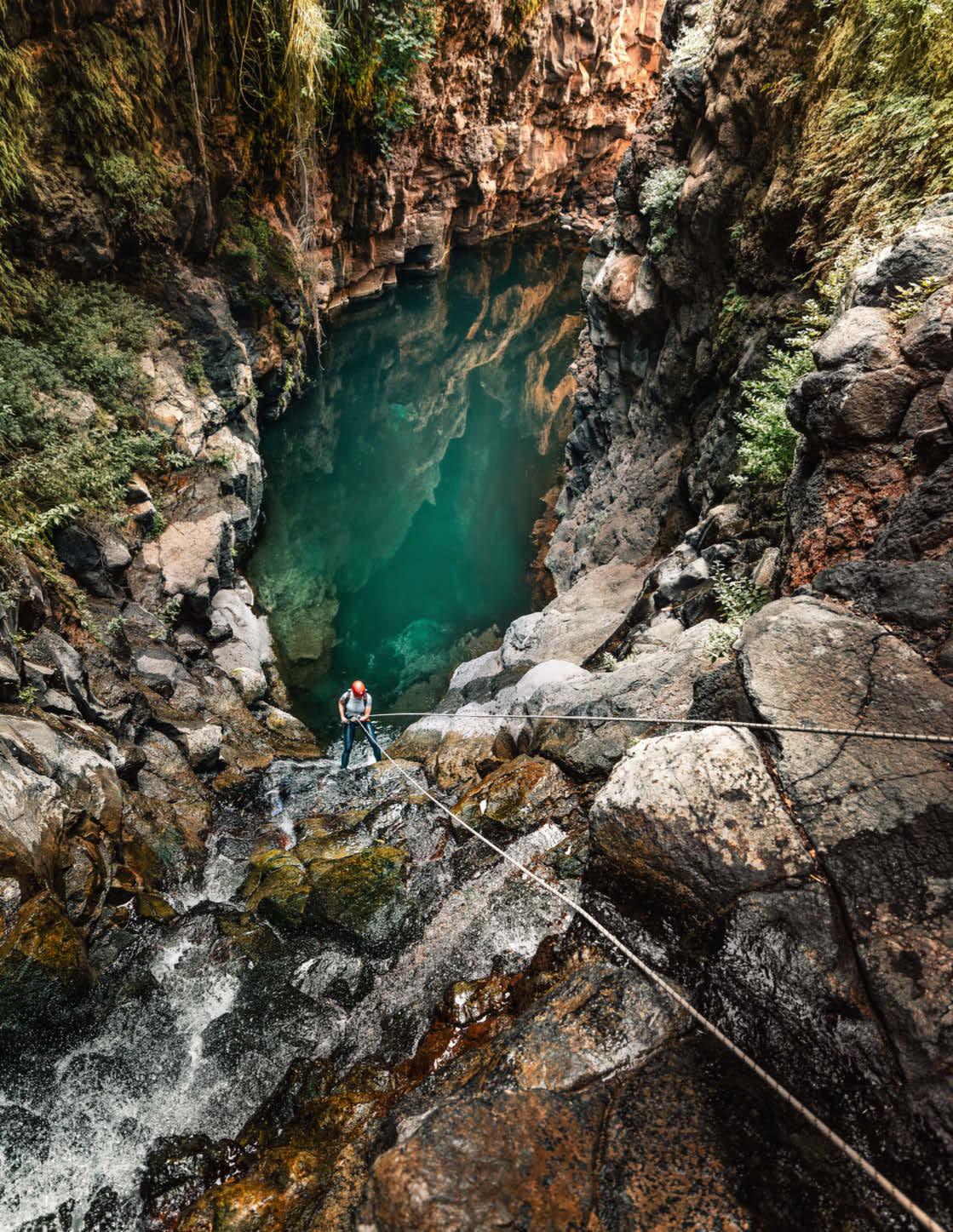
PROMOTION
commentator’s wise words, I drop into the darkness below.
The pool welcomes me with its cool embrace. The surface is adorned with floating flowers resembling an elaborate outdoor spa. Treading water, I relish the tranquil solitude cocooned within the canyon’s black walls, accompanied by the symphony of rushing water and the melodious chirping of birds. Shouts of “rope!” from above jolt me from my Zenlike state, urging me to swim to the other side of the pool, safely out of harm’s way for the next descender.
The hike through the canyon toward the third and final waterfall presents its own set of challenges. With no established trail along the creek bed, I find myself manoeuvring over boulders and wading through streams covered with slimy green algae, testing my balance. Making matters worse, my gaze continuously diverts from my feet to the oak trees clinging
Money talks: a 2,000-year-old coin from Sussita – an ancient city that was, until recently, buried beneath Israeli soil


precariously to rocks, remnants of jackal bones that whisper stories of the wild, and porcupine droppings that hint at the rich biodiversity surrounding us. Kama points out the bountiful array of edible plants lining the creek bed – Arabic oregano and wild marjoram used to make za’atar; figs, wild berries, asparagus, capers and wild almonds – which stirs a hunger within me.

Rather than conclude our day at the end of the Black Gorge Trail, requiring a climb of 450 steps back to the canyon’s edge, we opt to extend our adventure, hiking through lower Zavitan before ascending and descending into Meshushim Canyon in order to visit the Hexagon Pool oasis. Pausing along the way for a well-deserved break at Ein Nataf, I enjoy a refreshing and breathtaking outdoor shower created by a natural spring cascading down the canyon walls.
As the scorching sun hangs high in the sky, we indulge in a final plunge into the Hexagon Pool, named after the six-sided basalt columns that make up its walls. The inviting water embraces us, while the 40cm-wide columns create a psychedelic backdrop with their angled breaks. A satisfying conclusion to the adrenaline-pumping descents and muscle-straining scrambles, it’s the final scenic wonder in a day packed with surprises. Amy Jurries is an outdoor and adventure travel writer based in England, UK; Instagram: @thegearcaster. Stav Kama runs rappelling tours throughout Israel; kamatrails.co.il
PROMOTION
How to get there: the Black Gorge Trail is open from May to October, with advanced booking and a certified guide required. The best place to stay is the city of Tiberias on the shore of the Sea of Galilee – a two-hour drive from Ben Gurion International Airport in Tel Aviv
Down time: descending the gorge in the direction of the first rappel
JAKE BAGGALEY
HIGH FIVE Shoreditch
Home to independent bars, trendy restaurants and numerous street artists, this popular corner of the East End attracts both London locals and tourists in search of the true soul of the city
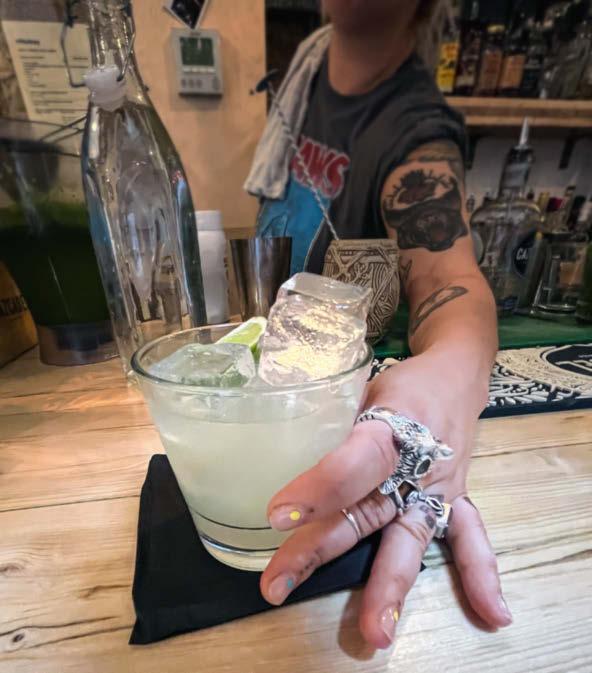
VENTURE Bars
3. Platform Gaming
With a menu containing 31 titles for the Switch and PlayStation, this bar promotes the social side of gaming. Book the Bottomless package for games, drinks and pizza at £35 per head. Come for: Mario Kart 8; bottomless brunch; work outings. 2b Worship St, EC2A; experienceplatform.co.uk


4. XOYO

Specialising in techno and house music, XOYO has one of the most popular dancefloors in London, with DJ sets at weekends and live music during the week. Buy tickets in advance and be ready for a party. Come for: electronic music; internationally renowned DJs; a night to remember. 32-37 Cowper St, EC2A; xoyo.co.uk
1. Home Bar
A spot that could never be described as spacious or chilled, and that’s just the way they like it. This tiny drinking hole is one of the friendliest in east London –just be sure to arrive early to nab a spot. Come for: the Margaritas; the lack of pretension. 5a Ravey St, EC2A; homeonravey.com
2. Long Arm
The first pub of its kind in the UK, Long Arm serves only unfiltered, unadulterated fresh beer, brewed in tanks on site – this eliminates the need for kegs and bottles, increasing sustainability. Come for: the beer selection; the pulled pork sandwich; daily sports on big screens. 20-26 Worship St, EC2A; longarmpub.co.uk
5. NQ64
Does playing arcade video games, sipping on a cocktail and digging into a double bacon cheeseburger sound like the perfect night out? NQ64 is the bar for you. Come for: Guitar Hero battles; a huge selection of retro arcade games; gaming-themed drinks such as the Kong Island Iced Tea. 256-260 Old St, EC1V; nq64.co.uk

4 3 2 WORSHIP STREET OLD STREET SCRUTTONSTREET EPWORTH CITY ROAD LEONARD STREET COWPER STREET WILLOW STREET RAVEY STREET SINGER STREET LUKE STREET PAUL STREET TABERNACLE GREATEASTERNSTREET STREET STREET
5 1 THE RED BULLETIN 93 LOU BOYD
VENTURE Calendar
Sept to 25 Nov RUMBLE IN THE JUNGLE REMATCH
October 30, 1974, saw arguably the biggest sporting event of the 20th century. The boxing match in Zaire –now the Democratic Republic of the Congo – between Muhammad Ali and undisputed heavyweight champion George Foreman was witnessed by an estimated one billion TV viewers. Now, we can all relive it through this immersive experience from ex-Secret Cinema creative director Miguel H Torres and advertising doyen (and “the world’s biggest Ali fan”) Trevor Beattie. A three-hour trip back in time to the Zaire ‘74 festival, with actors, multisensory stimulus, live music, food and drink, this is history in the remaking. Dock X, London; rumbleinthejunglerematch.com

September to 23 November OCEAN FILM FESTIVAL


Every year, this touring celebration of aquatic cinema hauls in a great catch of amazing stories. This year’s offerings range from the awe-inspiring (French big-wave surfer Thomas Traversa’s short but wild film The Storm Chaser) and the beautiful (Hypnotise – a look at the marine life living on an artificial reef inside the sunken wreck of an Australian Navy vessel) to the conscientious (in The Custodians, four Scottish locals try to save their coastlines) and the cute (Salty Sea Dogs: Spike sees a rescue dog become an Australian canine surf star). Touring nationwide; oceanflmfestival.co.uk
6 to 31 October
DANCE UMBRELLA
Hip hop is widely acknowledged as having been born at a house party in the Bronx in summer 1973, when DJ Kool Herc used two turntables to cut back and forth between classic funk tracks. Celebrating the 50th anniversary of that turning point is London Battle on October 7, a day of DJs and breakers from the four corners of the capital throwing down in cyphers at Somerset House. The event is part of London’s international dance festival Dance Umbrella – itself celebrating a 45th birthday – which also includes performances such as Greek dancer Xenia Aidonopoulou’s Skydiver (pictured). Across London; danceumbrella.co.uk
19 13
94 THE RED BULLETIN
VENTURE Calendar
29 to 30 September SONICA SURGE
Launched in 2001, audio editing and composing software Ableton Live has made creating electronic music easier and more accessible. Now one of its creators, German music artist Robert Henke, is diving back still further into the history of technology. His live show CBM 8032 AV (pictured) uses five 1980s Commodore computers to present a retro-futuristic aural and graphical spectacle. It’s part of Sonica Surge, a unique 48-hour festival of audiovisual art that also includes German robotics engineer Moritz Simon Geist making techno using dotmatrix printers and vacuum flasks. Tramway, Glasgow; sonic-a.co.uk

September onwards
BEHIND THE BULLET
The projectile referenced here isn’t made of metal; it’s the nickname of Jeffrey Herlings – the 29-year-old Dutch motocross rider and winner of the MXGP Championship in 2018 and 2021 – and he’s most certainly flesh and bone. “I don’t crash much, but when I do I always break bones,” he says in the opening episode of this second series, which tracks his 2023 season. After sitting out the 2022 Championship due to a foot injury, Herlings hopes to repeat the glory of his 2021 title win, but it’ll be a tough ride. In June, he suffered a fracture to his C5 vertebra, yet incredibly he returned to competition just six weeks later. Follow the unfolding drama as episodes roll out on Red Bull TV. redbull.com

1 to 7 October MAHABHARATA
This Sanskrit epic poem is central to Hindu mythology, dating back more than 2,000 years. Canada’s Why Not Theatre – part of the South Asian arts community in Toronto – has adapted its tales for a production that begins with a storyteller sitting beside a fire and then evolves into a technologically spectacular opera featuring dance, projections and traditional instruments. Barbican, London;barbican.org.uk

12
THE RED BULLETIN 95 THORSTEN INDRA/RED BULL CONTENT POOL, KEN REGAN/2023
ALI ENTERPRISES
PIETER KERS/BEELD.NU,
VAN
MUHAMMAH
LLC, NIKOLAS LOUKA,
MARCEL
HOORN/RED BULL CONTENT POOL, DAVID COOPER
The Red Bulletin worldwide
Editor Andreas Kornhofer
Editor-in-Chief
Andreas Rottenschlager
Editor-in-Chief DACH
David Mayer
Creative Directors
Erik Turek (manager), Kasimir Reimann
Copy Chief
David Pesendorfer
Art Directors
Marion Bernert-Thomann, Miles English, Tara Thompson
Designers
Martina de Carvalho - Hutter, Kevin Faustmann-Goll, Carita Najewitz
Photo Editors
Eva Kerschbaum (manager), Marion Batty (deputy), Susie Forman, Tahira Mirza, Rudi Übelhör
Global Content
Tom Guise (manager), Lou Boyd
Head of Audio
Florian Obkircher
The Red Bulletin is published in six countries. This is the cover of our Swiss edition for October, featuring mountaineer and free climber Nicolas Hojac. For more stories beyond the ordinary, go to: redbulletin.com
Managing Editors
Ulrich Corazza, Marion Lukas -Wildmann
Publishing Management

Sara Car-Varming (manager), Ivona Glibusic, Melissa Stutz (Innovator)
Head of Media Sales & Partnerships
Lukas Scharmbacher
Creative Services
Verena Schörkhuber-Zöhrer (manager), Sara Wonka, Tanja Zimmermann, Julia Bianca Zmek, Edith Zöchling-Marchart
Executive Creative Director
Markus Kietreiber
Senior Manager Creative
Elisabeth Kopanz
Art Direction Commercial
Peter Knehtl (manager), Lisa Jeschko, Araksya Manukjan, Julia Schinzel, Florian Solly
Head of Publishing Operations
Sigurd Abele
Direct to Consumer Business
Peter Schiffer (manager), Marija Althajm, Victoria Schwärzler, Yoldaş Yarar
Retail & Special Projects Manager
Klaus Pleninger
Advertising
Manuela Brandstätter, Monika Spitaler
Production
Veronika Felder (manager), Martin Brandhofer, Walter O. Sádaba, Sabine Wessig
Repro
Clemens Ragotzky (manager), Claudia Heis, Nenad Isailović, Sandra Maiko Krutz, Josef Mühlbacher
Finance
Mariia Gerutska
Assistant to General Management
Sandra Stolzer
CEO Red Bull Media House Publishing
Stefan Ebner
Editorial office
Am Grünen Prater 3, A-1020 Vienna Phone +43 1 90221 - 0 Web redbulletin.com
Published by Red Bull Media House GmbH, Oberst-Lepperdinger-Straße 11–15, A-5071 Wals bei Salzburg, FN 297115i, Landesgericht Salzburg, ATU63611700
Executive Directors
Dietmar Otti, Christopher Reindl, Marcus Weber
THE RED BULLETIN
United Kingdom, ISSN 2308-5894
Editor Ruth McLeod
Chief Sub-Editor
Davydd Chong
Country Project Management
Ollie Stretton
Advertising Sales
Mark Bishop, mark.bishop@redbull.com
Printed by Quad/Graphics Europe Sp. z o.o., Pułtuska 120, 07-200 Wyszków, Poland
UK Office
Seven Dials Warehouse, 42-56 Earlham Street, London WC2H 9LA Tel: +44 (0) 20 3117 2000
Subscribe getredbulletin.com
Enquiries or orders to: subs@uk.redbulletin.com. Back issues available to purchase at: getredbulletin.com Basic subscription rate is £20.00 per year. International rates are available. The Red Bulletin is published 10 times a year. Please allow a maximum of four weeks for delivery of the first issue
Customer Service +44 (0)1227 277248, subs@uk.redbulletin.com
THE RED BULLETIN
Germany, ISSN 2079-4258
Editor
David Mayer
Proofreaders
Hans Fleißner (manager), Petra Hannert, Monika Hasleder, Billy Kirnbauer-Walek
Country Project Management
Natascha Djodat
Media Sales & Partnerships
Thomas Hutterer (manager), Michael Baidinger, Franz Fellner, Ines Gruber, Moritz Philipp Haaf, Wolfgang Kröll, Gabriele MatijevicBeisteiner, Yvonne Mensik, Alfred Minassian, Nicole Okasek-Lang, Britta Pucher, Nicole Umsait, Johannes Wahrmann-Schär, Ellen Wittmann-Sochor, Ute Wolker, Christian Wörndle, Sabine Zölß
THE RED BULLETIN Switzerland, ISSN 2308-5886

Editor
Anna Mayumi Kerber
Proofreaders
Hans Fleißner (manager), Petra Hannert, Monika Hasleder, Billy Kirnbauer-Walek
Country Project Management
Meike Koch
Media Sales & Brand Partnerships
Christian Bürgi (team leader), christian.buergi@redbull.com
Marcel Bannwart, marcel.bannwart@redbull.com
THE RED BULLETIN
Austria, ISSN 1995-8838
Editors
Nina Kaltenböck (manager), Lisa Hechenberger
Proofreaders
Hans Fleißner (manager), Petra Hannert, Monika Hasleder, Billy Kirnbauer-Walek
Country Project Management
Julian Vater
Media Sales & Partnerships
Thomas Hutterer (manager), Michael Baidinger, Franz Fellner, Ines Gruber, Moritz Philipp Haaf, Wolfgang Kröll, Gabriele MatijevicBeisteiner, Yvonne Mensik, Alfred Minassian, Nicole Okasek-Lang, Britta Pucher, Nicole Umsait, Johannes Wahrmann-Schär, Ellen Wittmann-Sochor, Ute Wolker, Christian Wörndle, Sabine Zölß
Michael Wipraechtiger, michael.wipraechtiger@redbull.com
Goldbach Publishing
Marco Nicoli, marco.nicoli@goldbach.com
THE RED BULLETIN USA, ISSN 2308-586X
Editors
Peter Flax (manager), Melissa Gordon, Nora O’Donnell
Copy Chief
David Caplan
Country Project Management
Branden Peters
Advertising Sales
Marissa Bobkowski, marissa.bobkowski@redbull.com
Tanya Foster, tanya.foster@redbull.com
Todd Peters, todd.peters@redbull.com
THE RED BULLETIN
France, ISSN 2225-4722
Editors
Pierre-Henri Camy (manager), Marie-Maxime Dricot, Christine Vitel
Country Project Management
Marin Heitzler
Media Sales & Partnerships
Yoann Aubry, yoann.aubry@redbull.com
Dave Szych, dave.szych@redbull.com
The Red Bulletin UK. ABC certified distribution 139,678 (Jan-Dec 2022)
GLOBAL TEAM 96 THE RED BULLETIN
Cold steel: Jonny Pain on his Beyond the Ultimate Ice Ultra, which he completed in February this year

ENDEAVOUR THROUGH ADVERSITY

How ThruDark athlete Jonny Pain took his mind and body to the limits of endurance on an epic 250km Arctic trek
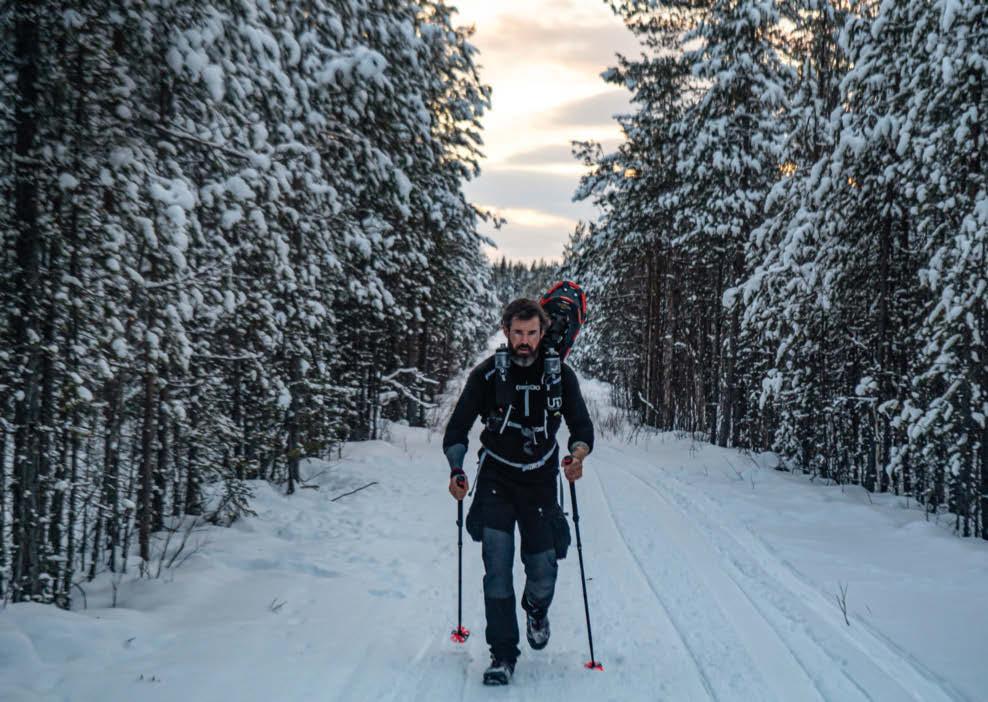
Sometimes ‘endeavour’ isn’t about breaking new ground, but about finding what was lost. Finding that is something only you can do. ThruDark athlete Jonny Pain’s Arctic ultra was never about finding new physical or worldly realms, but about the rediscovery of a state of mind once thought lost.
It was a physical, mental and at times explicit verbal challenge he issued to himself; the ability to beat himself up, talk himself down, belittle and overcome his own personality at the same time. It was this capacity to take himself to the edge physically and mentally, to face not only the adverse camber of a physical challenge but the explicit admonishment of his
own thoughts, that helped Jonny complete the 250km trek. Perhaps there really is no single word for this experience that can explain the inner fire you unearth when both body and mind have turned against you.
As the man in the arena, only Jonny can know what it felt like to survive the fear on his first night, to come through the storm and cross the finish line. Only he can know what it felt like to rediscover a fire he thought no longer existed. This was a mission of his own doing, for his own cause. We can follow it, like it and share it, but we will only ever be observers watching on. We are mere spectators of an ‘Endeavour Through Adversity’ that is truly personal to Jonny Pain.
PROMOTION BEYOND THE ULTIMATE
Semi-Rad
Adventure philosophy from BRENDAN LEONARD
“In outdoor sports, we have many pieces of equipment that aren’t very useful outside their intended usage. Ice-climbing tools, for example, are only useful for a very specific task and not much else, especially in summer. Downhill skis and the boots that click into them are basically a prosthetic you only use to move on snow, in a downward direction, after you’ve got a ride to the top of an incline. Cycling clothing, especially items designed for inclement weather, is up there, too. Blocks the wind, but only from the front. Holds in heat in certain places, lets it out in others. Keeps fingers warm as they remain in the same position for hours at a time. It works, but if you try wearing it for something else, it doesn’t quite work as well. As my friend Tom once told me about cycling through the winter, ‘On a bike, you always have wind chills.’”
The next issue of THE RED BULLETIN is out on October 10

98 THE RED BULLETIN
ENHANCE YOUR ABS AND BACK WORKOUT
Muscle Stimulation controlled by smartphone-app coaching tracks your progress and helps you stay focused on your goal



COMPEX.COM

TISSOTWATCHES.COM
TISSOT prx 35 mm automatic
A SWISS MADE THROWBACK TO A FLAGSHIP TISSOT DESIGN FROM 1978































 Santa Rosa, Guatemala
Santa Rosa, Guatemala


 Watch
Lennart Neubauer’s Wind Park at redbull.com
Watch
Lennart Neubauer’s Wind Park at redbull.com








 Ambassador Leo Houlding
Ambassador Leo Houlding

















 STEVE DAVIES
STEVE DAVIES





 Caine Harrison is ready to go again at this year’s Red Bull Dance Your Style World Final
Caine Harrison is ready to go again at this year’s Red Bull Dance Your Style World Final


 Words TOM WARD
Photography HAMISH BROWN
Words TOM WARD
Photography HAMISH BROWN


























 Words JESSICA
HOLLAND P hotography SAMANTHA SASKIA DUGON
Words JESSICA
HOLLAND P hotography SAMANTHA SASKIA DUGON







 Fine line: (from top) Ferguson (left) and Bergemann are blown away by the course; Blewitt goes again after last year’s crash
Fine line: (from top) Ferguson (left) and Bergemann are blown away by the course; Blewitt goes again after last year’s crash







 Northern exposure: Bad Boy Chiller Crew, photographed for The Red Bulletin at the O2 Academy Leeds in May this year
Northern exposure: Bad Boy Chiller Crew, photographed for The Red Bulletin at the O2 Academy Leeds in May this year






















 Zak Noyle
Zak Noyle










































































































































































 Sasha DiGiulian, Jacopo Larcher and Babsi Zangerl.
Hold tight: Shauna Coxsey boulders in the Verzasca valley; (opposite) the climber and her husband Ned take a hike with a view of Lake Maggiore; (opening page) tackling a rockface in Ticino
Sasha DiGiulian, Jacopo Larcher and Babsi Zangerl.
Hold tight: Shauna Coxsey boulders in the Verzasca valley; (opposite) the climber and her husband Ned take a hike with a view of Lake Maggiore; (opening page) tackling a rockface in Ticino



















 Top row, from left: MIZU V6 Bottle, mizulife.eu; CAMELBAK Forge Flow Vacuum Insulated Stainless Steel Travel Mug 350ml, camelbak.co.uk; KLEAN KANTEEN Insulated Classic 20oz, kleankanteen.co.uk
Bottom row: CONTIGO Chill Autoseal Vacuum Insulated Water Bottle 720ml, mycontigo.com; SNOW PEAK Titanium Aurora Bottle 800, uk.snowpeak.com; CHILLY’S Series 2 Flip, chillys.com; STANLEY Go Quick Flip Water Bottle 0.70L, uk.stanley1913.com
Top row, from left: MIZU V6 Bottle, mizulife.eu; CAMELBAK Forge Flow Vacuum Insulated Stainless Steel Travel Mug 350ml, camelbak.co.uk; KLEAN KANTEEN Insulated Classic 20oz, kleankanteen.co.uk
Bottom row: CONTIGO Chill Autoseal Vacuum Insulated Water Bottle 720ml, mycontigo.com; SNOW PEAK Titanium Aurora Bottle 800, uk.snowpeak.com; CHILLY’S Series 2 Flip, chillys.com; STANLEY Go Quick Flip Water Bottle 0.70L, uk.stanley1913.com
 Top row: HYDRAPAK Recon 25oz/750ml, hydrapak.com; LIFESTRAW LifeStraw Go Series 1L BPA Free Water Filter Bottle, eu.lifestraw.com; BLACK+BLUM Glass Water Bottle, black-blum.com; HYDRO FLASK 21oz Standard Mouth with Flex Straw Cap, hydroflask.com
Bottom row: AIR UP Ocean Blue Bottle, uk.air-up.com; DOMETIC Thermo Bottle 66, dometic.com; ZOKU 18oz Stainless Steel Flip Top Sports Bottle, zokuhome.com; YETI Rambler 18oz (532ml) Bottle, uk.yeti.com
Top row: HYDRAPAK Recon 25oz/750ml, hydrapak.com; LIFESTRAW LifeStraw Go Series 1L BPA Free Water Filter Bottle, eu.lifestraw.com; BLACK+BLUM Glass Water Bottle, black-blum.com; HYDRO FLASK 21oz Standard Mouth with Flex Straw Cap, hydroflask.com
Bottom row: AIR UP Ocean Blue Bottle, uk.air-up.com; DOMETIC Thermo Bottle 66, dometic.com; ZOKU 18oz Stainless Steel Flip Top Sports Bottle, zokuhome.com; YETI Rambler 18oz (532ml) Bottle, uk.yeti.com











































